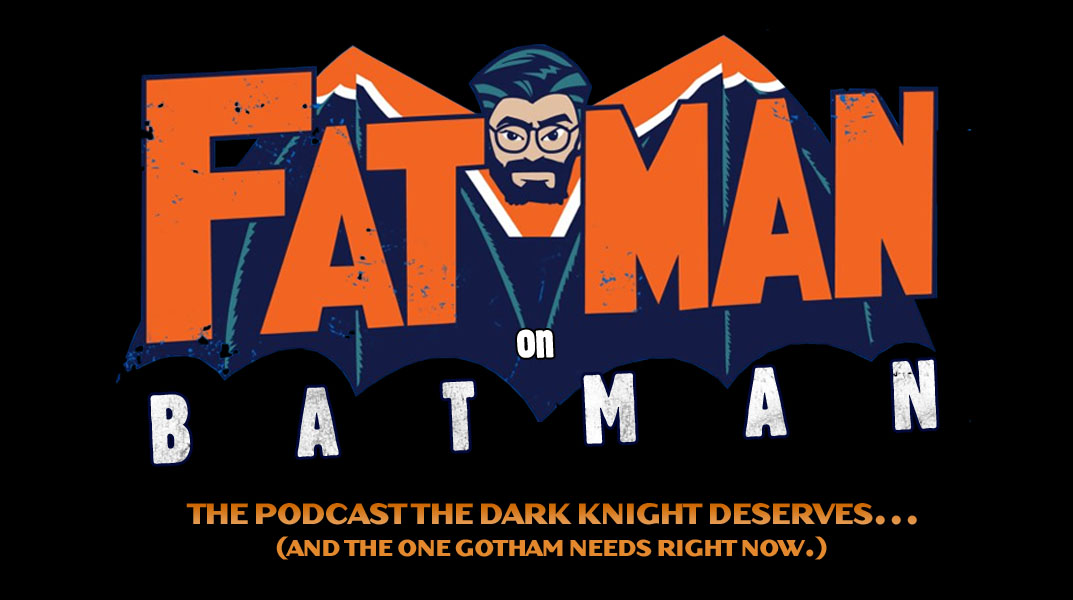 |
Holy High-Praise Batman! Film-maker, podcaster, retailer and huge Batman fan Kevin Smith (Clerks, Mallrats, Jay and Silent Bob Strike Back) gave this feature special mention on his "Fatman on Batman" podcast calling it "an excellent piece"! Thanks Kevin - we are big fans on this site! |
INTRODUCTION
Christopher Nolan's The Dark Knight Rises (2012) features many references to the Batman comics. In some cases these are elements adapted directly from the source material. In other instances they're elements subverted to manipulate audience expectations. What follows is an overview of the references we spotted in the movie.
As with our previous comic references features, our objective is not only to recognize the filmmakers' research in the source material, but also to credit the many significant comic book writers and creators whose work was adapted in the movie. Without them, these films would not have been possible.
THE DARK KNIGHT RISES AND THE COMICS
The first major character we meet in The Dark Knight Rises is Bane. The look of the character was completely redesigned from his comic counterpart and bears more of a resemblance to Ubu, Ra's al Ghul's loyal henchman from the comics. Ubu first appeared in Dennis O'Neil's 'Daughter of the Demon' (Batman #232, June 1971), but in later stories, he was depicted wearing a mask to cover his facial disfigurements. In Chuck Dixon's Bane of Demon (1999), Bane fights and defeats this masked version of Ubu and takes his place at Ra's' side.
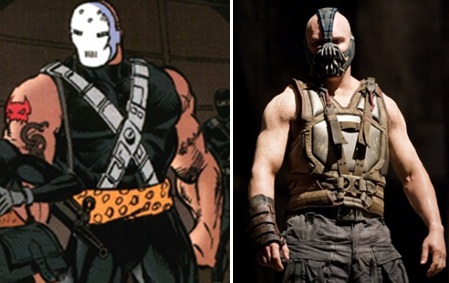
After Bane kidnaps Dr. Pavel, the film transitions to Harvey Dent Day at Wayne Manor. Here we meet several new characters, starting with Mathew Modine's Deputy Commissioner Peter Foley. Foley was likely inspired by Hugh Foley, a GCPD officer who was featured prominently in the No Man's Land story arc. The character was tragically shot dead in the comics. His onscreen namesake meets a similar demise towards the end of the film.
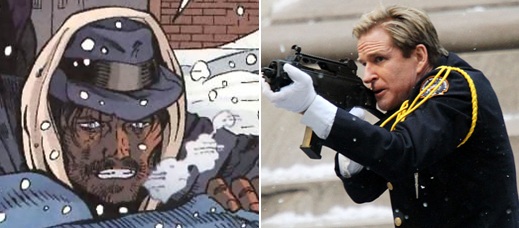
Later at the party, Foley mentions that Commissioner Gordon's wife took his kids and moved away from Gotham. Gordon's career has often interfered with his marriage iIn the comics. The most notable example is Jeph Loeb's Dark Victory, in which it was revealed that Barbara Gordon had separated from her husband and moved away, taking their son, James Jr., with her.
The next major character introduced at the party is Talia al Ghul, posing as executive 'Miranda Tate,' who hopes to team with Bruce Wayne in a quest to use nuclear fusion for clean energy. She later becomes a high-ranking member of the board of Wayne Enterprises.
The comic book Talia has also served as a corporate exec. Lex Luthor appointed her, under the name of Talia Head, as the CEO of LexCorp when he became the President of the United States. But like Miranda's intentions towards Bruce in the film, Talia secretly planned to undermine Luthor.
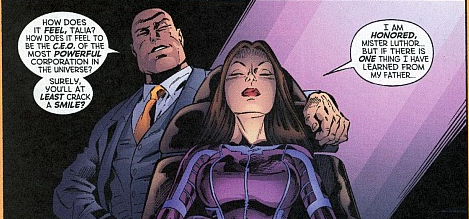
The other executive villain, John Daggett, may have been inspired by Roland Daggett from Batman: The Animated Series, who first appeared in the episode 'Feat of Clay' by Marv Wolfman and Michael Reaves. Both characters are corrupt businessmen who try to take control of Wayne Enterprises.
The Daggett from the film also bears similarities to Max Shreck, one of the villains in Tim Burton's Batman Returns (1992), created by screenwriter Daniel Waters. Shreck, Roland Daggett and John Daggett are all outwardly legitimate businessmen who are secretly engaged in criminal activities. All three men come into conflict with both Catwoman and Bruce Wayne. Shreck and John Daggett also both enter into covert alliances with other villains and are ultimately betrayed by their co-conspirator.

All of the aforementioned characters discuss the fact that their host, Bruce Wayne, has become reclusive over the years, not even showing up to his own party. This is strongly reminiscent of Frank Miller's The Dark Knight Returns (1986). Aside from bearing a similar sounding title to The Dark Knight Rises, Miller's work also has the premise of Bruce Wayne hanging up the cowl and becoming a reclusive loner with a death wish.
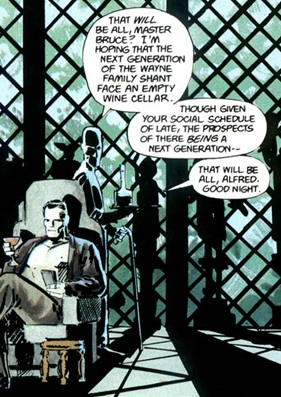
In the comic he's been in retirement for ten years, in the movie it's eight. But in both cases we see Bruce as a man who has lost all purpose in life, whiling away his time reliving painful memories in the shadowy halls of Wayne Manor.
Bruce in The Dark Knight Returns hung up the cowl due to the loss of the second Robin, Jason Todd, as well as the government's banning on superheroes.
Similarly, Bruce in The Dark Knight Rises has stopped being Batman due to the Harvey Dent Act cleaning up the streets and has become a recluse in Wayne Manor because of the loss of his childhood love, Rachel Dawes.
Bruce Wayne also has facial hair in the beginning of both stories, but shaves it off later when it's time for him to return to his old life.
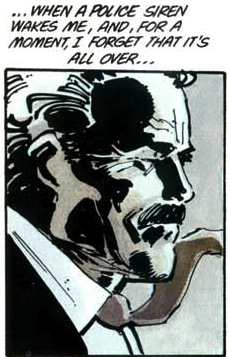
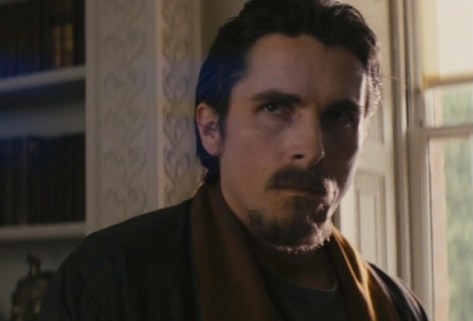
His first appearance in the film sees him confronting a maid who has trespassed into his private chambers. The maid is in fact Selina Kyle, a professional thief who's attempting to acquire samples of Bruce Wayne's fingerprints, using the theft of Martha Wayne's pearl necklace as a pretext to cover her true agenda. Bruce sees through her disguise and attempts to stop her her, but Selina escapes. He isn't able to retrieve his mother's necklace until later, when he next reunites with Selina at Miranda Tate's costumed ball.
This very much stays true to Selina Kyle's first historical appearance in Bill Finger's 'The Cat' (Batman #1, 1940). Instead of a cat-like costume, the character originally disguised herself as an old lady named Miss Peggs in order to steal the Travers diamond necklace during a yacht party. Batman was able to see through her disguise and recover the necklace, though the Cat herself escaped.
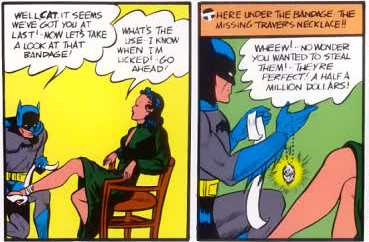
It's worth noting that Selina Kyle is never referred to as 'Catwoman' in The Dark Knight Rises,although we do see newspaper headlines referring to her by her early comic book name, 'the Cat'.
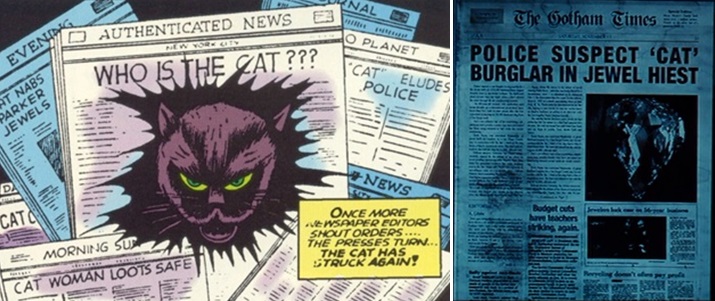
After the Wayne Manor sequence, the film transitions to the GCPD rooftop, where we meet Nolan's version of Robin, Officer John Blake. As noted by fans at the time of Joseph Gordon-Levitt's casting, the name "Johnny Blake" showed up in Jack Schiff's 'A Comedy of Tears' (Batman #13, 1942) as a child who gets his report card stolen by the Joker. The scene was later recreated in the 256 Pages Super Heroes Coloring Book.
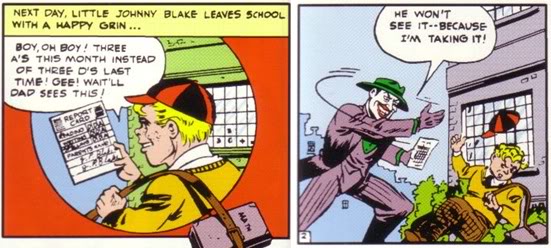
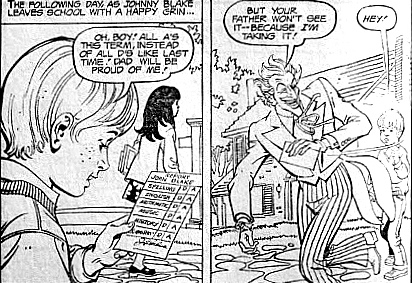
Since young Blake and the film's Blake have nothing else in common, it's likely the shared name is a coincidence.
The name 'John Blake' does however have connections to Robin and several other characters in the comics. For one thing, 'John' is the middle name of Dick Grayson. 'John' is also a homophone of 'Jean', which could be construed as a reference to Jean-Paul Valley, the man who succeeded Bruce Wayne as Batman during the Knightfall story arc. Lastly, 'Blake' rhymes with 'Drake', the surname of the third Post-Crisis Robin Tim Drake.
On the surface Blake would appear to be a completely original take on the concept of Batman's sidekick. But he does have some parallels with Dick Grayson from the comics. First of all, both characters are orphans.
Secondly, Blake grew up in a Catholic orphanage, St. Swithin's. Prior to being taken in by Bruce Wayne, the Post-Crisis Dick Grayson also lived in a Catholic orphanage. The character of Father Reilly in the film can be seen as a parallel to Sister Mary Elizabeth, the kindly nun who took care of Dick in Marv Wolfman's Batman: Year Three (1989).

Thirdly, Blake is a cop, as was Dick Grayson during Chuck Dixon's run on Nightwing. He began training to become a policeman in 'Bad Night in Bludhaven' (Nightwing #31, May 1999) and was accepted onto the force in 'The Sylph, Part One: Slender Thread' (Nightwing #48, October 2000). He continued to serve with the Bludhaven Police Department throughout the early 00s.
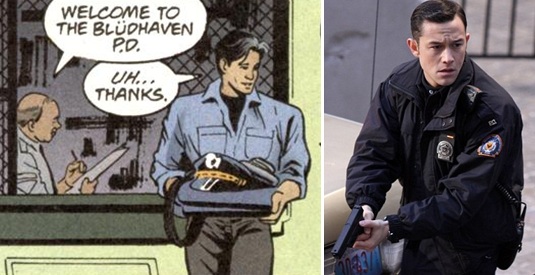
In the film, we see Blake's investigative skills in action when he looks into the death of a teenage orphan and discovers that someone's been recruiting transients to work in the sewers beneath the city.
This is the first of many parallels between the movie's narrative and The Cult, a 1988 comic by Jim Starlin. In The Cult the villain Deacon Joseph Blackfire recruits homeless people to join his army, using the sewers as a base from which to plot their extreme tactics to rid Gotham of crime and corruption.


The result is that the Gotham City streets seem to be mysteriously empty and devoid of crime in the beginning of the story, much like The Dark Knight Rises.
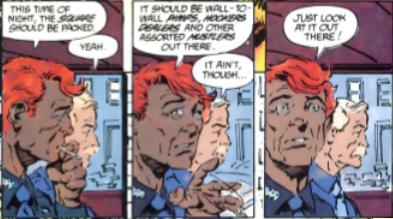
While the comic directly states that this is a result of Blackfire's followers doing his bidding, the film's 'crime-less' Gotham is a result of the Harvey Dent Act.
The Dark Knight Rises perhaps draws more on Starlin's The Cult than on any other comic. This will be evident in later examples.
Among the poor and destitute in Gotham is Selina's friend, Jen, who is introduced at the bar when the two women confront Mr. Stryver. Selina seems to act like a big sister to Jen, protecting her in a later scene when a man nearly assaults the young girl for stealing his wallet. This character, and her sidekick-like relationship to Selina, seems to be Nolan's version of Holly Robinson, a character introduced in Frank Miller's Batman: Year One (1987).
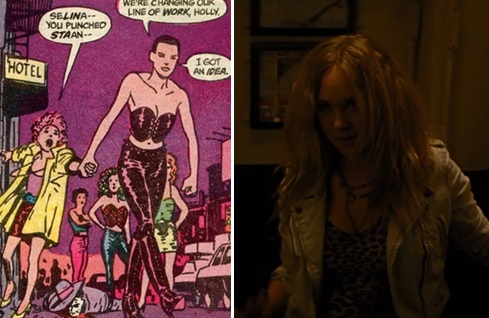
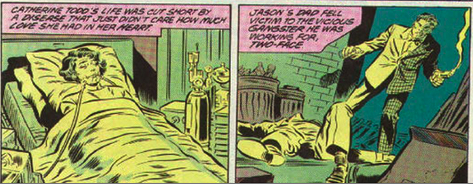
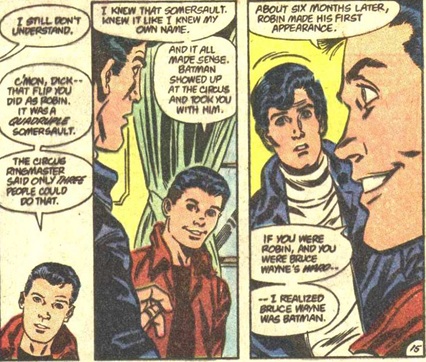
While A Lonely Place of Dying was the likely influence, the scene in The Dark Knight Rises also bears similarities to the Elseworlds comic Nine Lives (2002) by Dean Motter. In this story, Dick Grayson/Robin is reimagined as an ex-cop and private detective. He deduces Batman's true identity and confronts a robed Bruce Wayne with his suspicions:
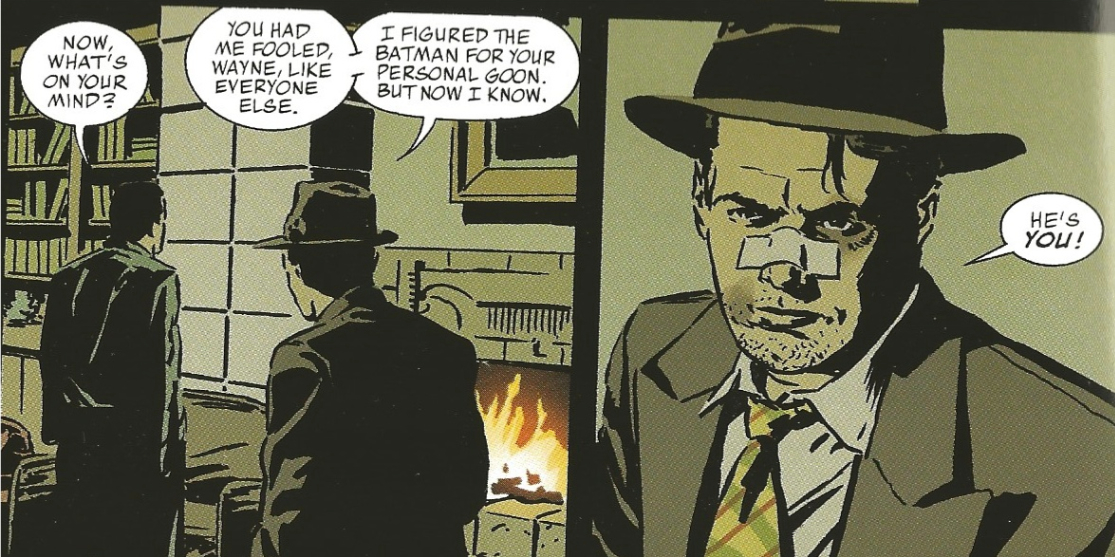
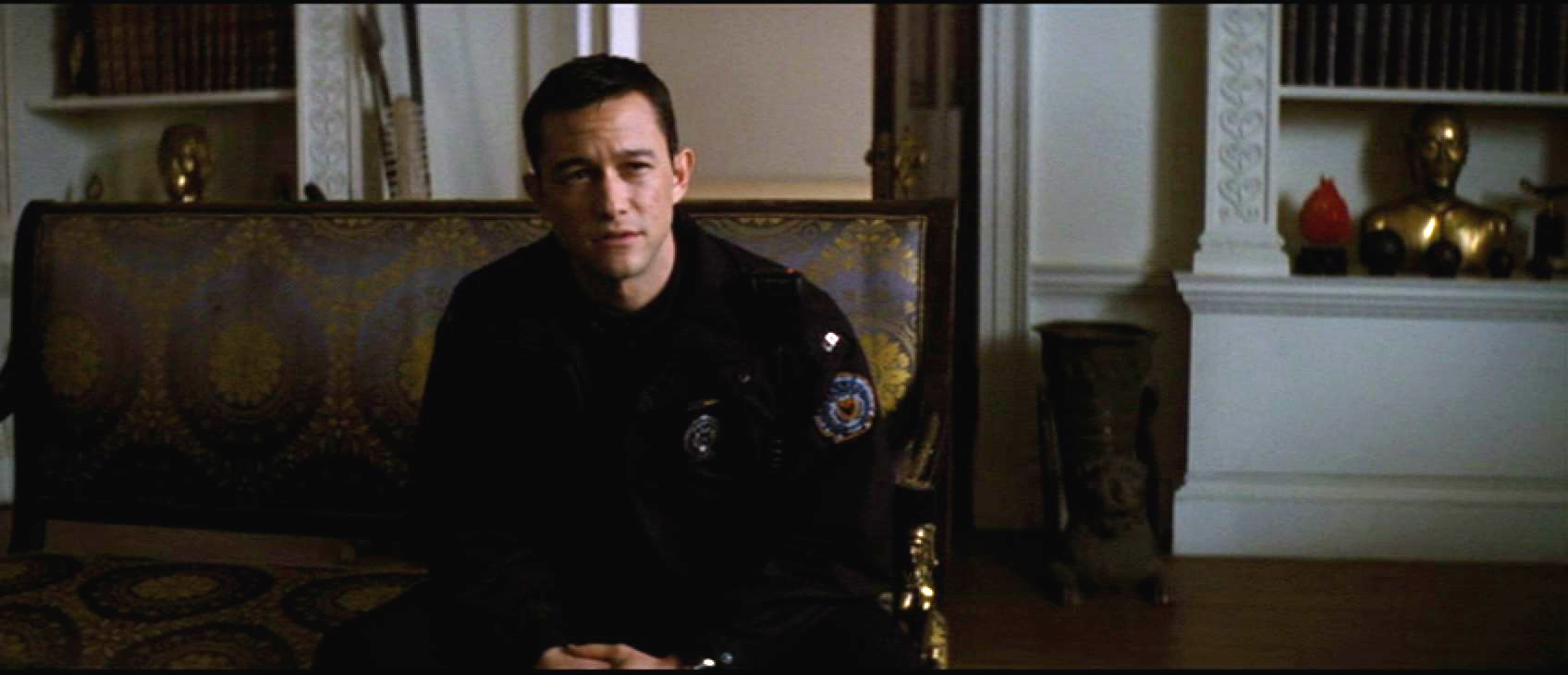
Blake's words inspire Bruce to go out and investigate. His first act is to visit Commissioner Gordon, who's recovering in the hospital after his encounter with Bane's men. This scene has parallels with Starlin's The Cult, in which Batman's first move after returning to the city is to visit Gordon as he convalesces in hospital, having earlier been wounded by Deacon Blackfire's men.
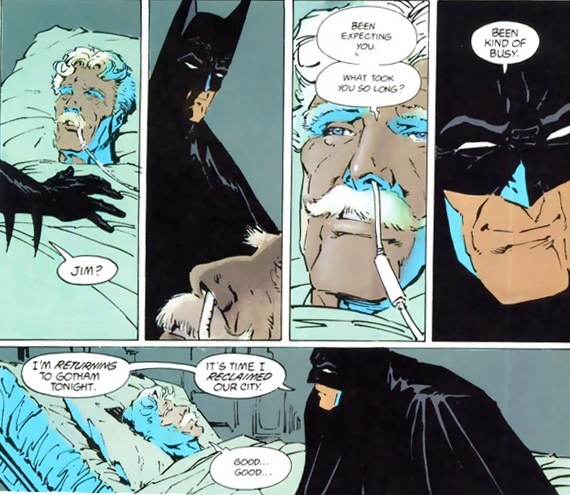
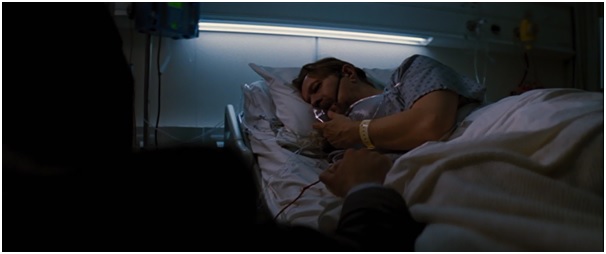
Bruce Wayne steps back into the public eye when he attends Miranda Tate's masquerade ball. There he encounters Selina Kyle for the second time and the two of them dance while Bruce tries to recover his mother's necklace.
This scene is possibly a nod to the memorable masquerade ball sequence in Batman Returns (1992), from the screenplay by Daniel Waters and Wesley Strick. In both movies, Bruce shows up at the party without a mask – the idea being that his public persona is a mask in itself – and engages in a moral discussion with Selina while they dance.
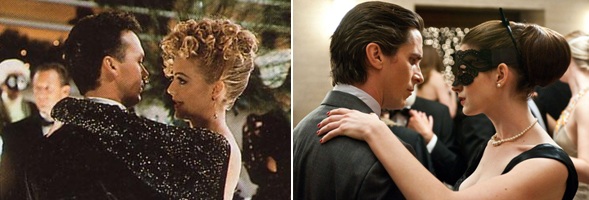
Once Bruce returns to the Batcave, he attaches a leg brace to his damaged knee, preparing himself to don the mantle of Batman again. The idea of Bruce needing a brace to compensate for his physical frailty is another nod to Miller's The Dark Knight Returns.
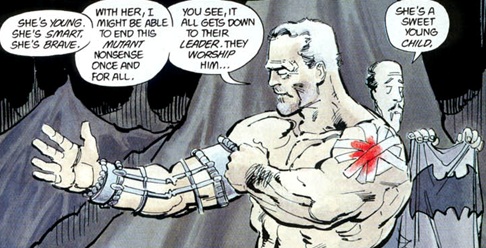

During this scene Alfred tells Bruce everything he has learned about Bane, including the fact that the latter used to be a member of the League of Shadows. While not part of his backstory in the comics, Bane did become affiliated with the League of Shadows' comic counterpart, the League of Assassins, in Chuck Dixon's Bane of Demon. It was during his tenure with the League that he was romantically linked to Talia al Ghul.
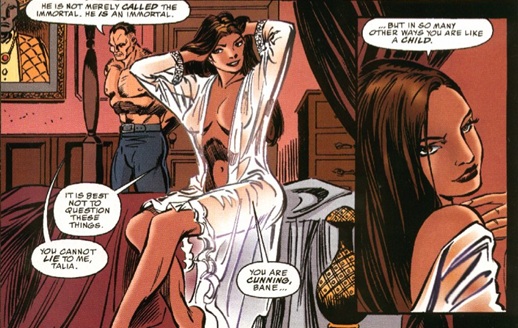
Bane became Ra's al Ghul's bodyguard, Ubu, at the end of Bane of the Demon and throughout Dixon's story arc Batman: Legacy. There, Bane and Bruce Wayne's Batman fought in a rematch that ended in Bane's defeat. Due to his failure, Ra's deemed Bane to be unworthy of his daughter and their alliance was dissolved. This may have influenced the backstory in The Dark Knight Rises where Ra's excommunicated Bane from the League of Shadows.
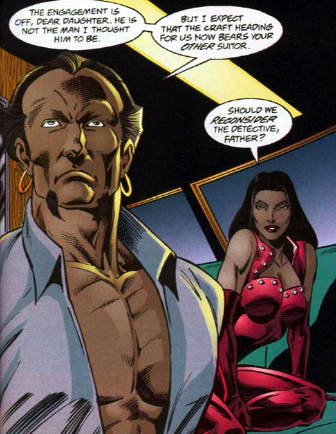
Bane's first public attack on Gotham is at the Gotham Stock Exchange. The police arrive and amongst them is a SWAT leader played by actor Rob Brown. He sports a nametag with the name "Allen" on it and makes a quip about keeping his money in his mattress. Given the character's last name and race, it's possible that Allen is a reference to Detective Crispus Allen, who first appeared in Greg Rucka's Detective Comics #742.
In the comics, Detective Allen was partnered with Renee Montoya and had already made the rank of Detective by the time he moved from Metropolis to Gotham. The only official onscreen portrayal of Detective Allen was in the animated Nolanverse tie-in Batman: Gotham Knight (2008), in which he was voiced by Gary Dourdan.
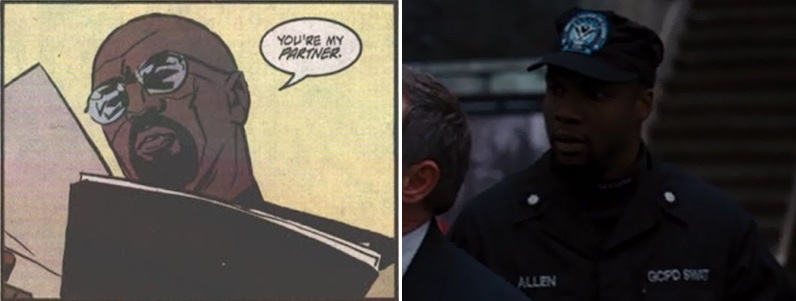
Bane's stock exchange heist culminates in an intense car chase. The intensity escalates further when Batman enters the fray, making his first public appearance in eight years. As in The Dark Knight Returns, his arrival is met with frightened wonder by a rookie cop and joyful awe by his veteran partner. The older cop tells the younger that he's "in for a show."
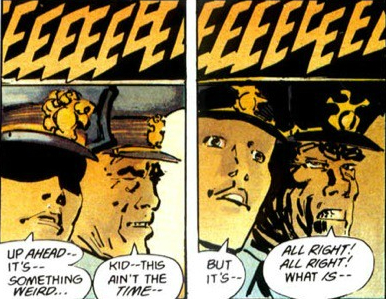
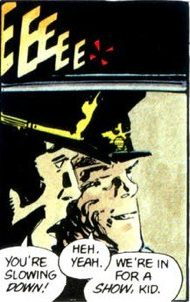
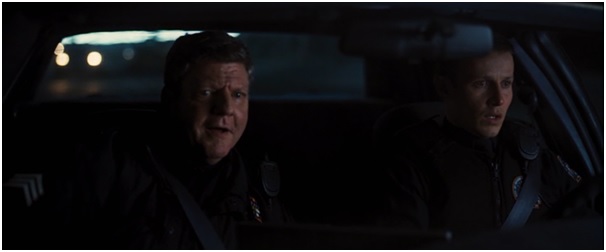
Batman's return is televised all over the city and we see the reactions from several characters, including Catwoman. This is the first time we see Selina wearing her costume. The design bears notable similarities with the outfit Catwoman wore in the 1960s comics and television show.
Catwoman's outfit traditionally includes a cat-eared cowl. But the 1966 Batman TV show broke this trend by having the Julie Newmar Catwoman sport a cat-eared headband and eye mask. This revised outfit made its debut in the comics in Gardner Fox's 'Catwoman Sets Her Claws For Batman' (Batman #197, December 1967), first seen on the cover art by Carmine Infantino and Mike Esposito and penciled throughout the issue by Frank Springer.
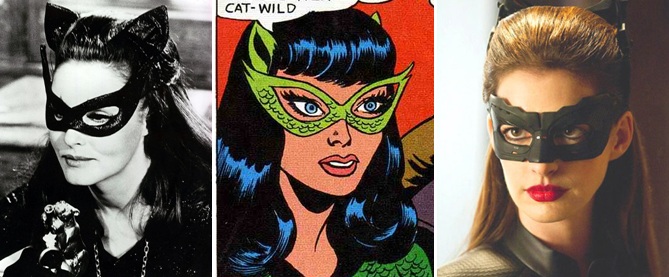
While the cat ears on Hathaway's costume are actually goggles, the Catwoman in the comics has been wearing both goggles and a cat-eared cowl since Darwyn Cooke redesigned her for Catwoman: The Dark End of the Street (2002).

The rest of Anne Hathaway's costume is similar to the sixties outfit, consisting of a skin-tight suit, high heel boots and gloves. This version does however lack the claws and whip of the comic book Catwoman.
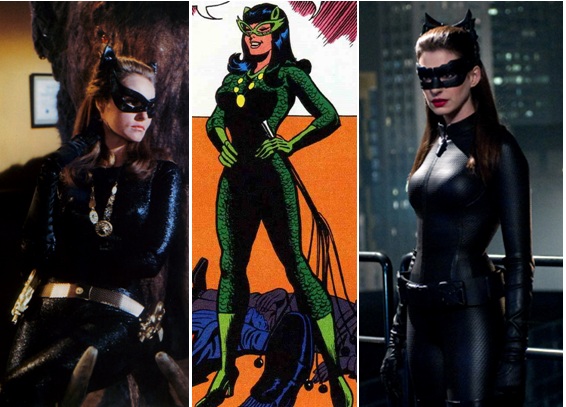
In her first scenes in costume, Selina is searching Daggett's penthouse for the 'Clean Slate,' a software program that will eliminate her records and allow her a fresh start. Her comic book counterpart succeeded in doing this with the aid of a computer virus, as mentioned in Jo Duffy's Catwoman #1 (1993).
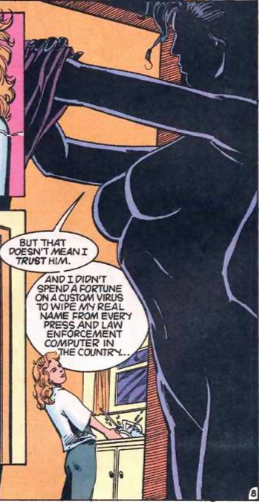
It's clear in the film that Selina has a troubled past. And while the skeletons in her closet are never fully disclosed, they might well be an allusion to her murky past in the Post-Crisis comics: specifically her background as a prostitute in Miller's Year One and her possible ties to the Falcone crime family, as developed in Jeph Loeb's The Long Halloween, Dark Victory, and Catwoman: When In Rome.
Catwoman's confrontation with Daggett ends with Batman showing up and helping her. Afterwards Batman questions Catwoman for information. He is momentarily distracted by a police chopper, and when he looks back he finds Catwoman has disappeared. Batman then remarks, "So that's what that feels like." This echoes a similar scene in Mark Waid and Alex Ross' Kingdom Come (1996), in which Superman disappeared on Bruce, prompting the same line of dialogue.
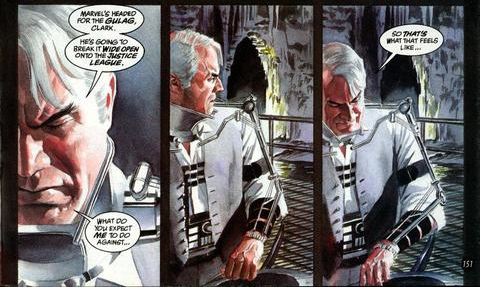
Kingdom Come also features an older Bruce Wayne and takes place in an alternate future in which Batman did not recover from Bane's attack and had to wear braces to support his crippled body.
In The Dark Knight Rises, it's because of Bruce's age and insistence on crime fighting that Alfred resigns his post at Wayne Manor. In the comics, Alfred gave notice when Bruce made a similar decision in Dennis O'Neil's 'Quarry Part II' in Knightquest: The Search (May 1994). In both stories, Alfred's resignation was a protest against Bruce endangering himself further, in spite of his broken body.
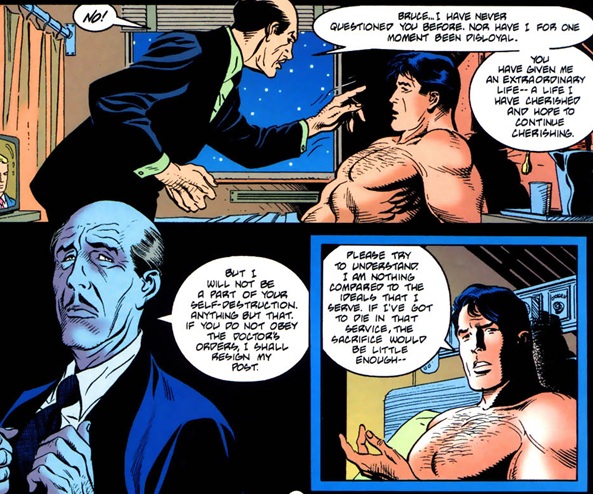
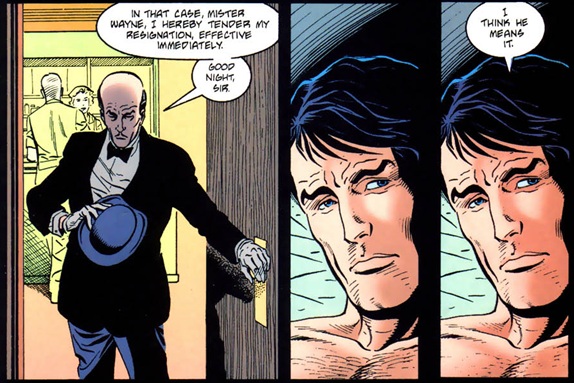
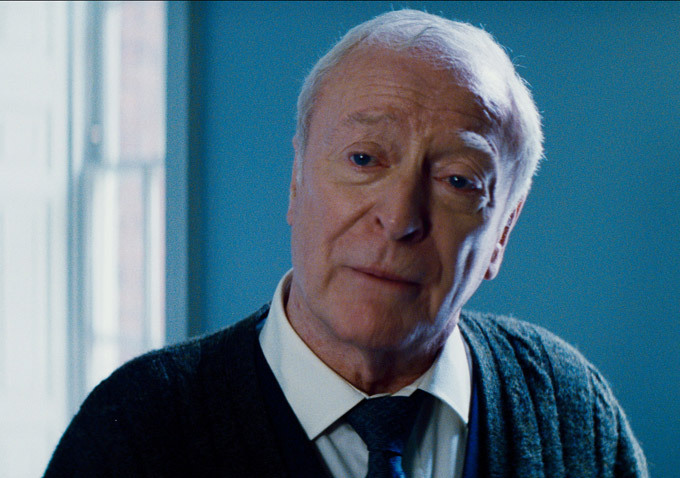
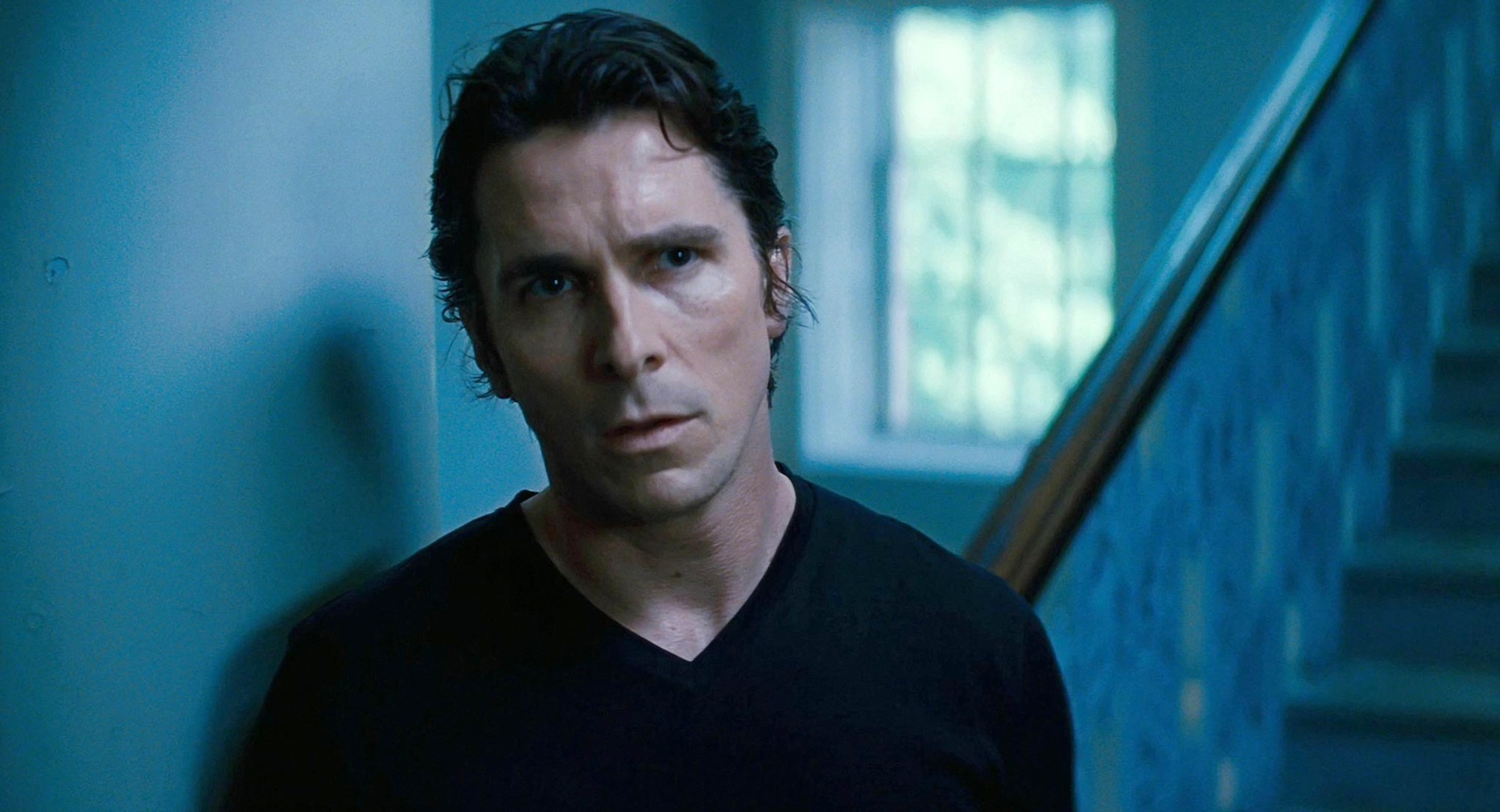
This marks the beginning of Bruce Wayne's downfall. He then loses his money, his company, his car, and even his electricity in what seems like a single day. During this time, Talia, still posing as Miranda Tate, and Bruce have a brief romantic affair and sleep together in Wayne Manor, providing the only instance in The Dark Knight Trilogy in which Bruce Wayne has sex. Bruce Wayne and Talia also sleep together in Mike W. Barr's Batman: Son of the Demon (1987).
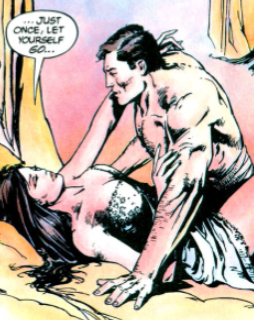
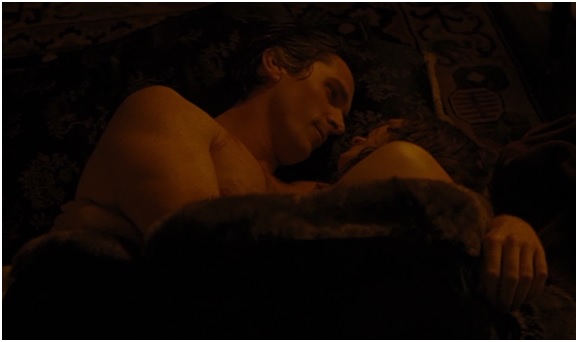
In the comics, this would result in the conception of Batman's son - Tallant Wayne in the Elseworlds Brotherhood of the Bat (1995), Ibn al Xu'ffasch in Kingdom Come, and Damian Wayne in Batman and Son (2006).
Later that night Batman meets with Catwoman in the hope that she will lead him to Bane. Their alliance appears to be going well until Catwoman double-crosses Batman by leading him into Bane's trap.
In the comics, Catwoman and Bane formed a brief alliance, as first seen in Knightfall's 'Knights in Darkness' by Doug Moench (Batman #498). However it never involved tricking or betraying Batman.
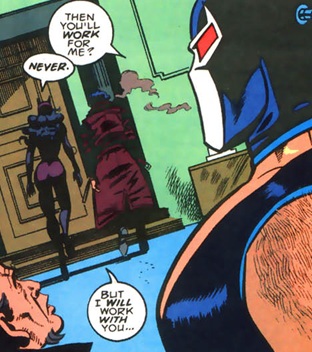
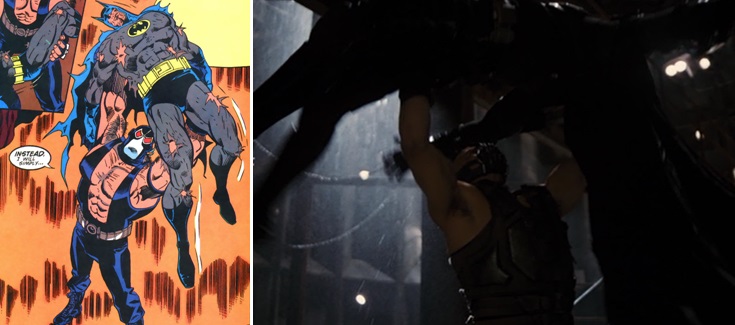
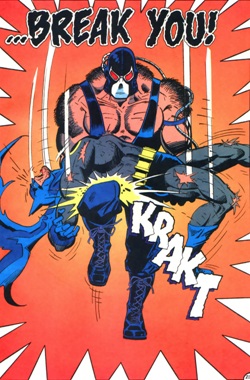
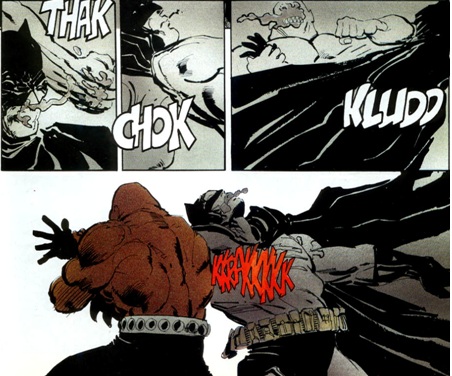
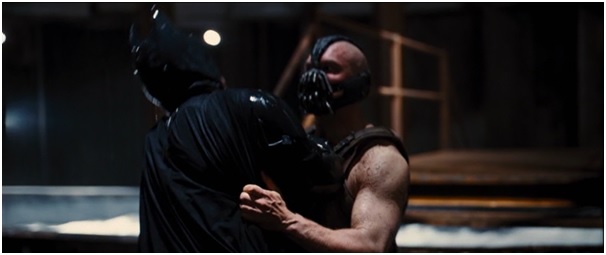
He later confronts this enemy again for a rematch, this time besting his adversary and re-establishing his supremacy.
Starlin's The Cult was heavily influenced by The Dark Knight Returns and has a similar structure, with Batman being "broken" by the villain, only to return later to defeat him in front of his underlings.
In Starlin's story, Batman battles Deacon Blackfire in the sewers of Gotham as the villain's cult looks on from above.
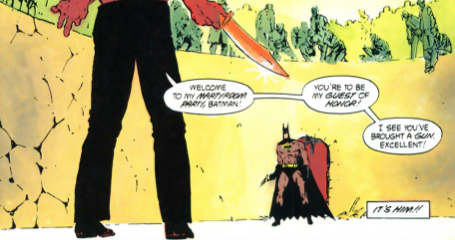
Batman manages to defeat and humiliate Blackfire, refusing to give the man the "honorable death" he craves and choosing to break him instead.
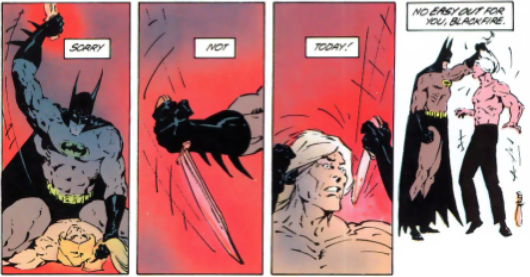
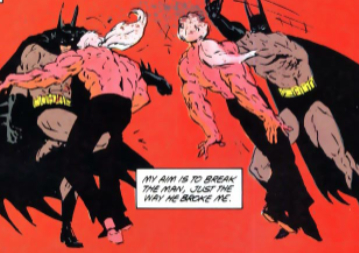
The outcome is obviously different in the film, with Bane recognizing Batman's death wish and choosing to break him rather than kill him. But the setting of the Gotham underground is the same. And the context is also similar, with the fight taking place before an audience of the villain's followers.
After Bane defeats Bruce, he imprisons him in The Pit, seeking to psychologically torture him by leaving him broken and alive to witness his city's defeat. It is then that Bane utters the famous line, "...when Gotham is ashes...then you have my permission to die."
A similar line is uttered in Dennis O'Neil's 'Where Strike The Assassins' (Detective Comics #489) by a different League of Assassins leader, The Sensei.
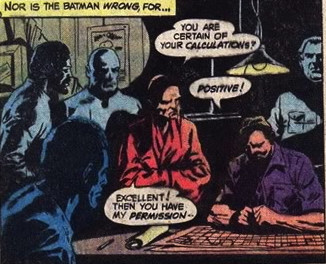
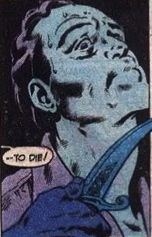
After leaving Bruce in the Pit, Bane returns to Gotham and goes public with his plans, beginning with the assassination of Mayor Garcia. The Mayor in The Cult met a similar explosive fate when he was killed by the blast from a car bomb.
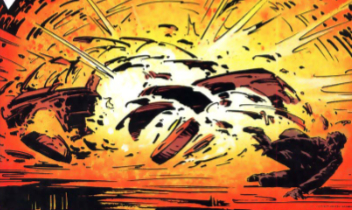
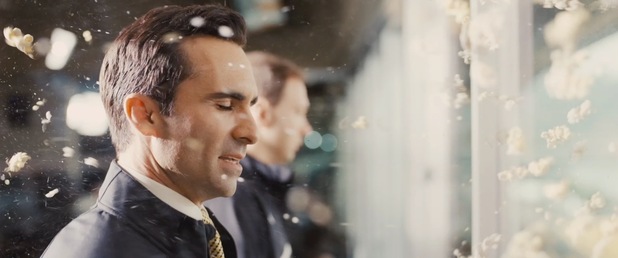
This plot point in the comic and the movie may also have been influenced by The Dark Knight Returns, in which the Mutant Leader slaughters the Mayor when he tries to negotiate with him in his prison cell.
After the Mayor's death, Bane arrives on the football field to announce his plans. His objective to finish Ra's al Ghul's campaign against Gotham is similar to the plot of Chuck Dixon's Batman: Bane (May 1997), a one shot that rounded off the Legacy story arc.

In the comic, Bane plans to destroy Gotham by overloading the reactor core of a nuclear power plant. As in the movie, the nuclear core in the comic was meant to be an energy source, but Bane repurposes it into a bomb.
Bruce in the story is aware of its capabilities due to Wayne Enterprises having made similar progress in clean energy. In the movie, the nuclear device actually comes from Bruce's own company.
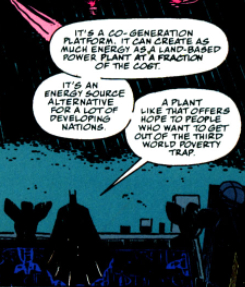
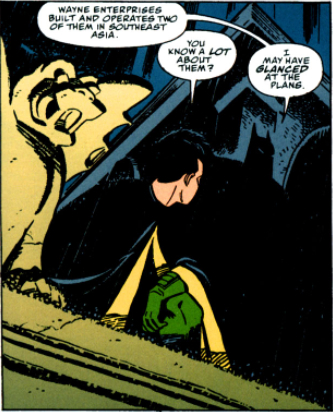
In both stories, Bane gives a public ultimatum to the city, threatening doom if they do not comply with his demands.
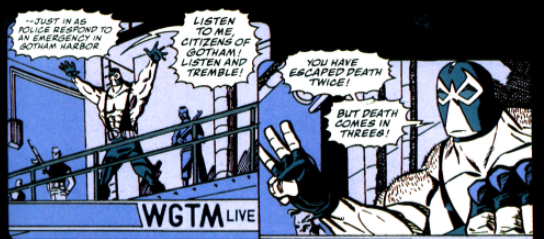
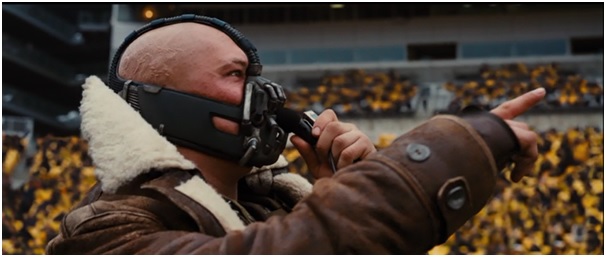
As in the movie, this is merely a distraction. Bane fully intends to detonate the core anyway once it's ready to blow.
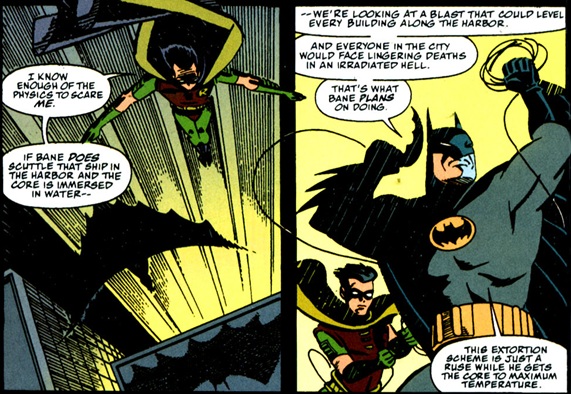
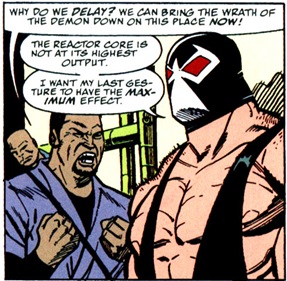

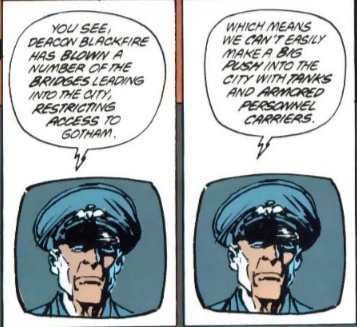
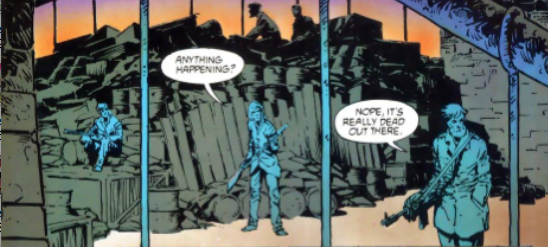
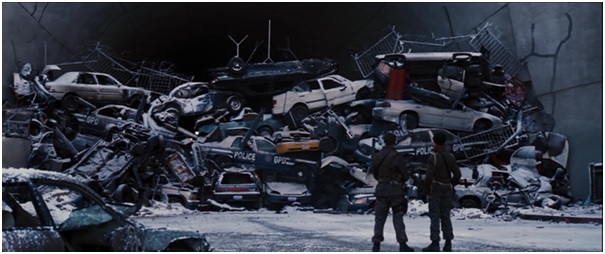
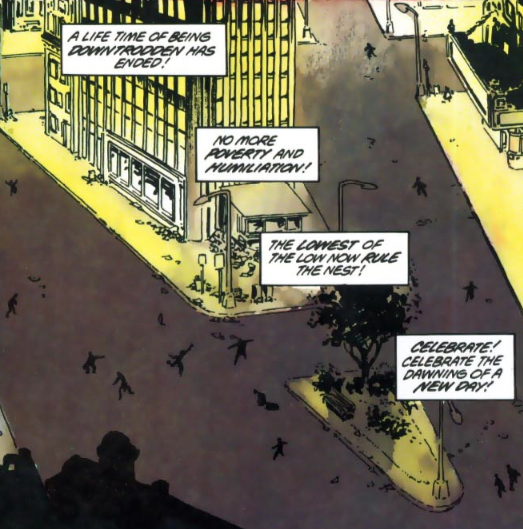
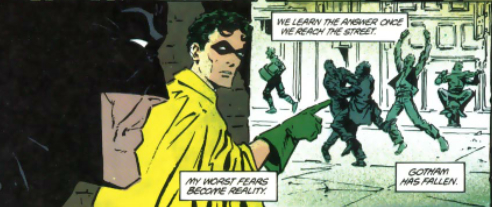
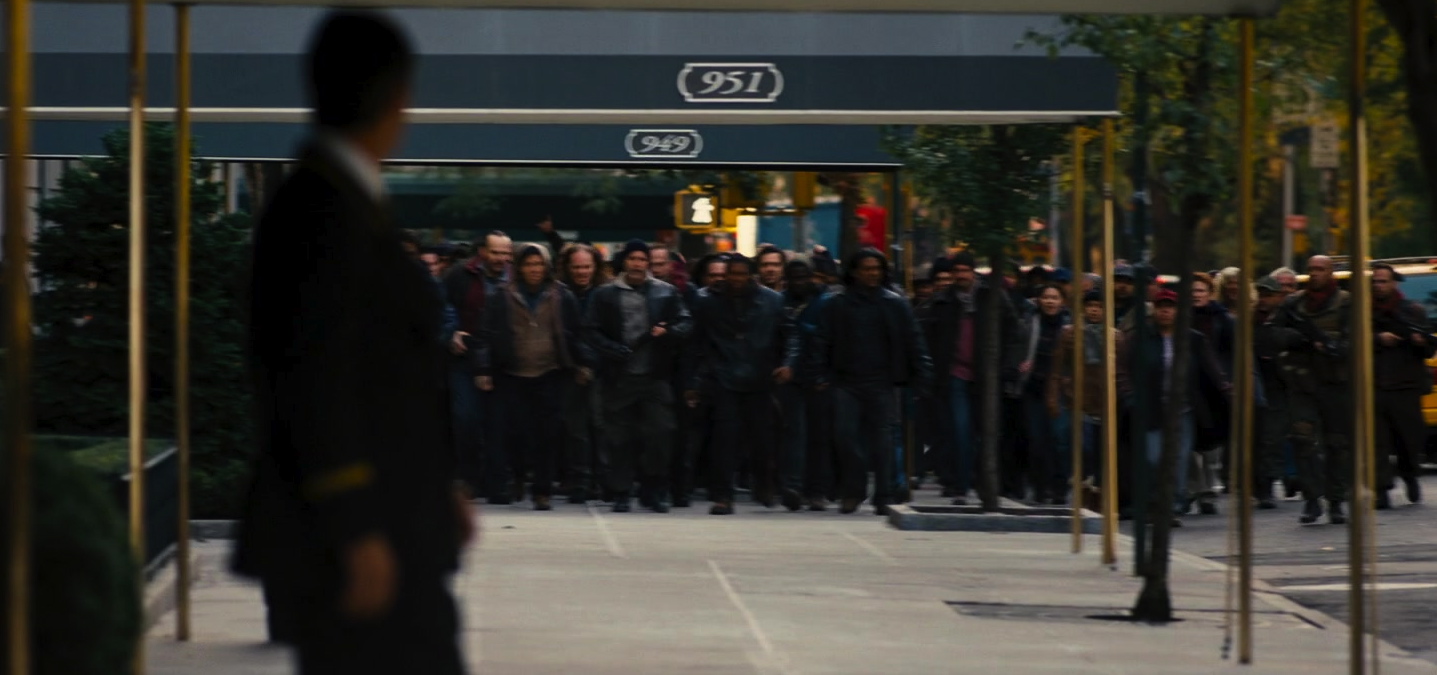
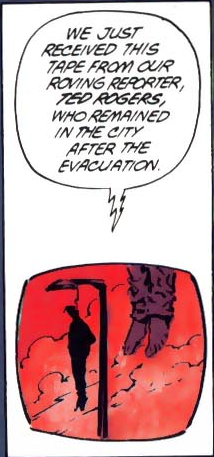
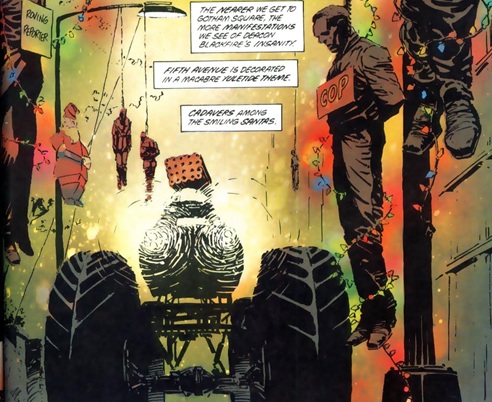
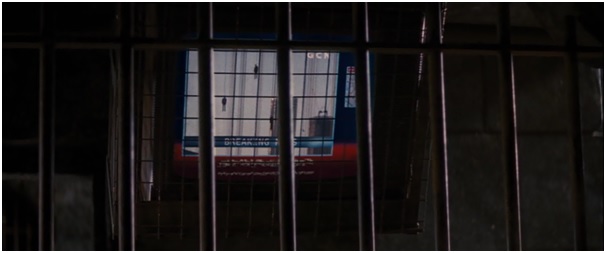
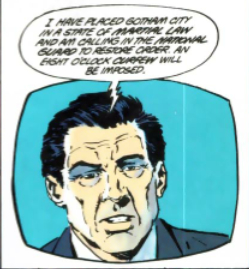
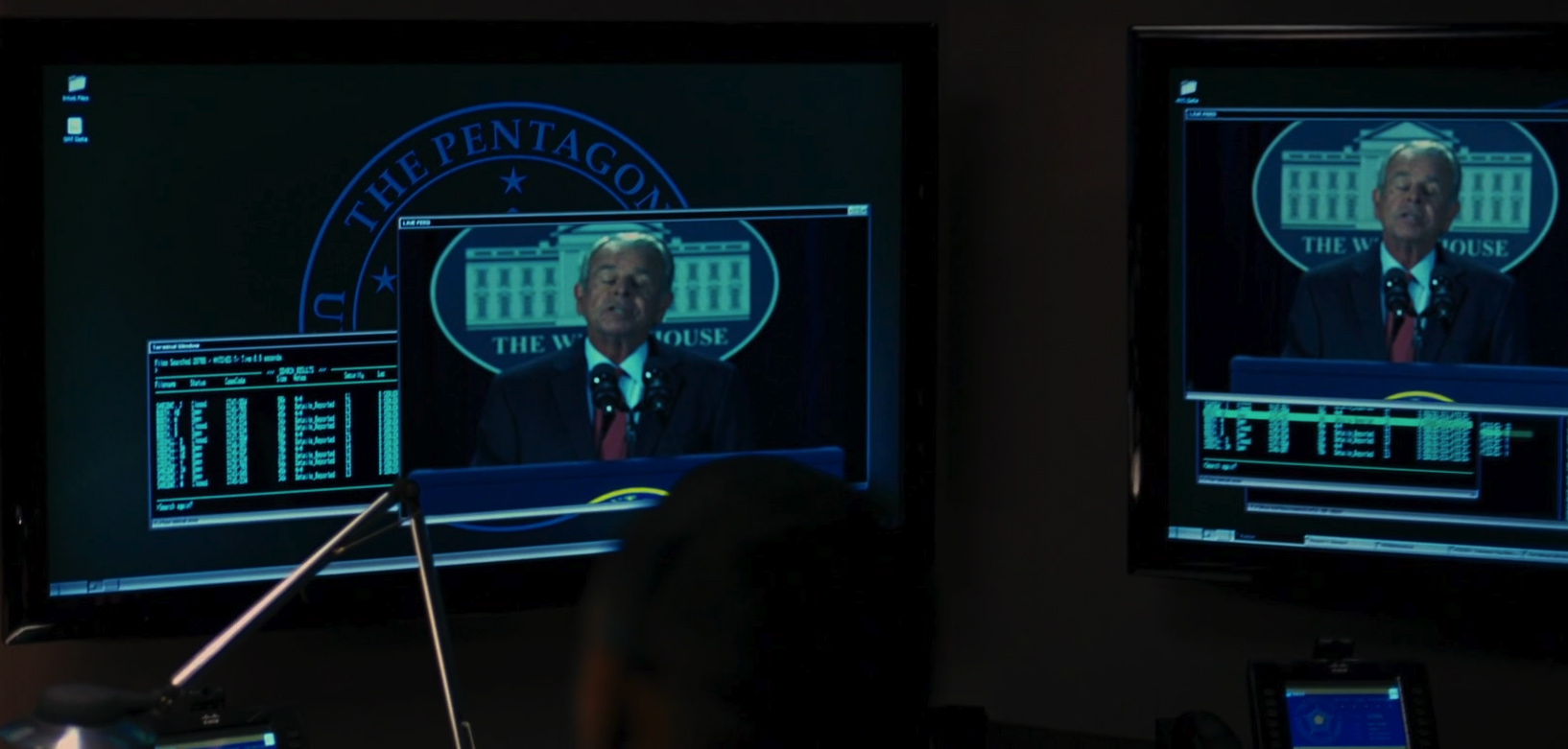
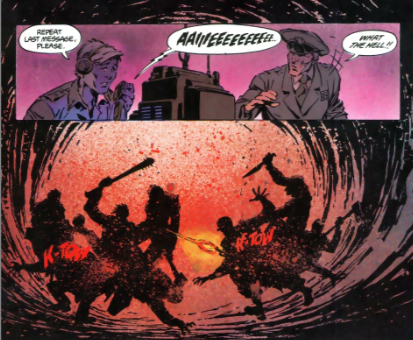
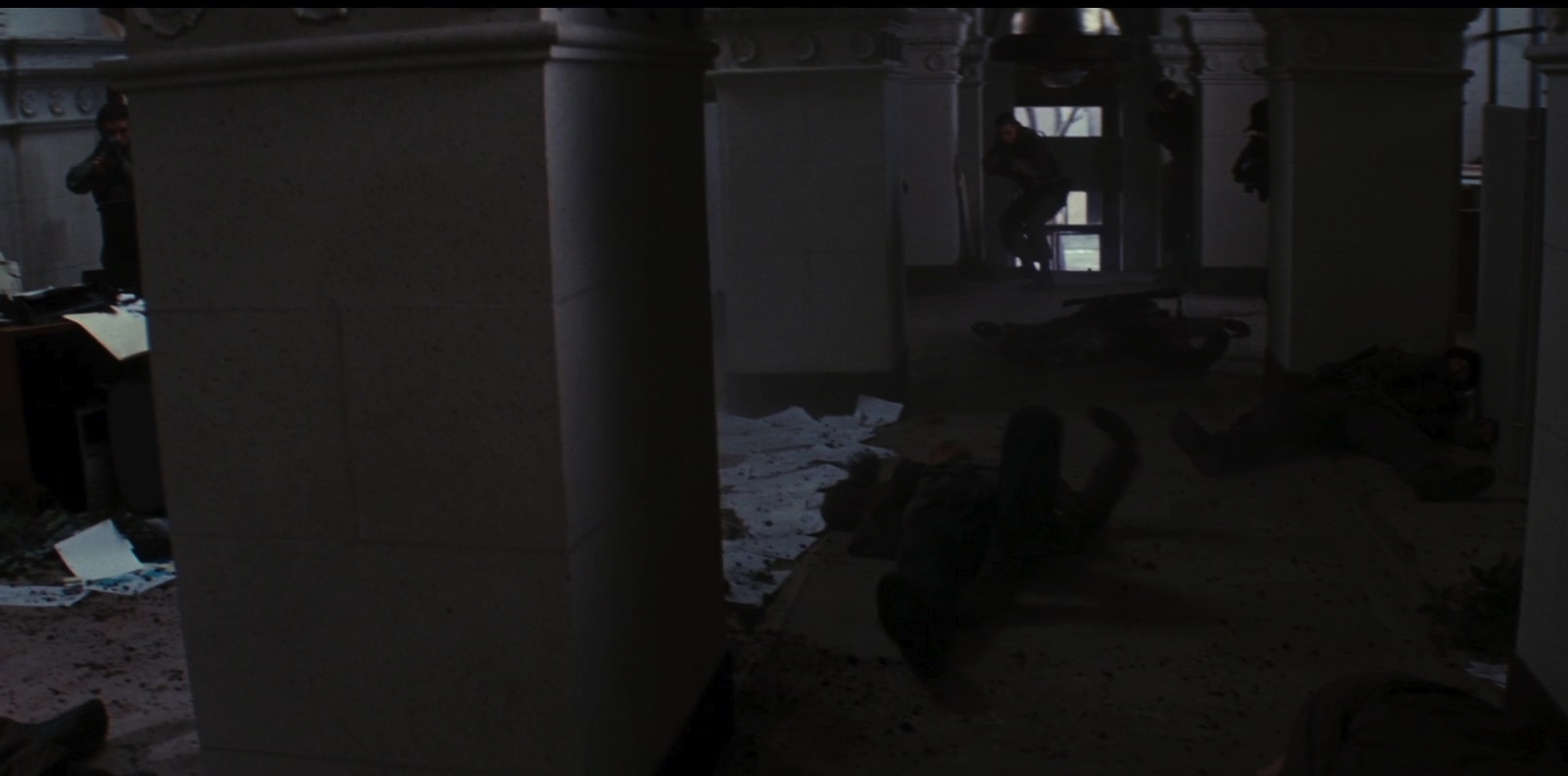
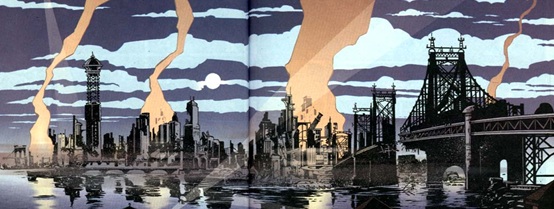
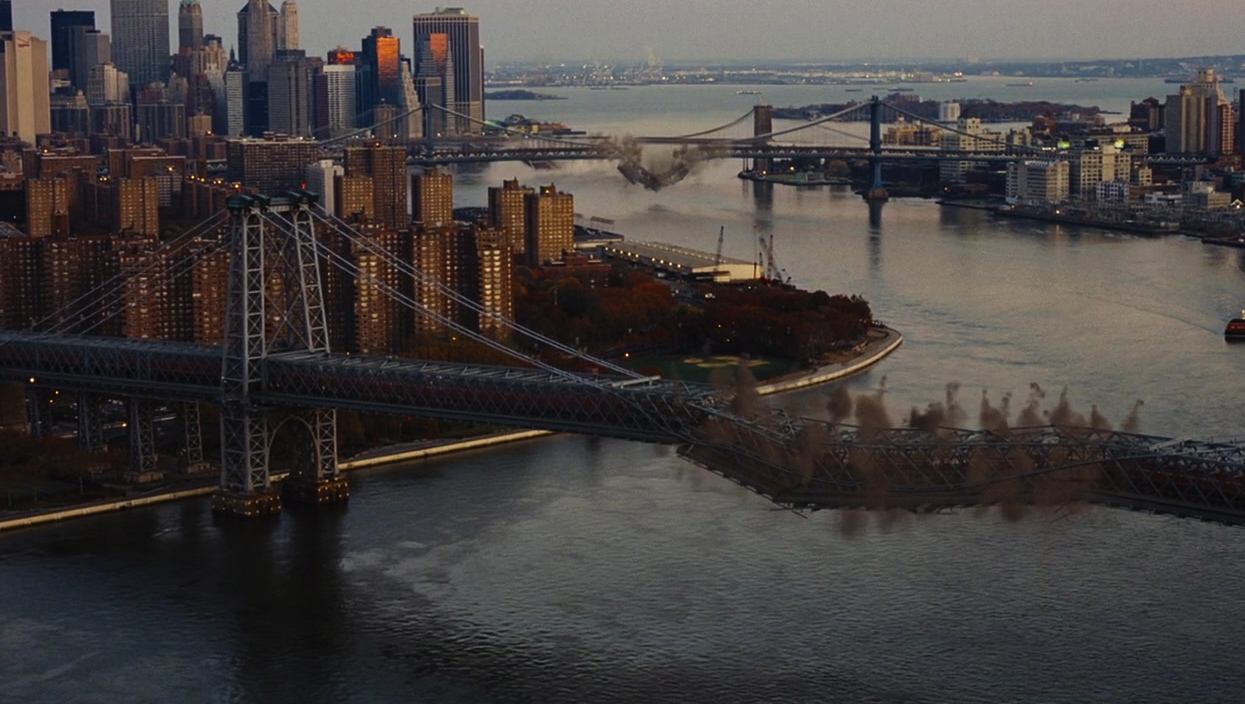
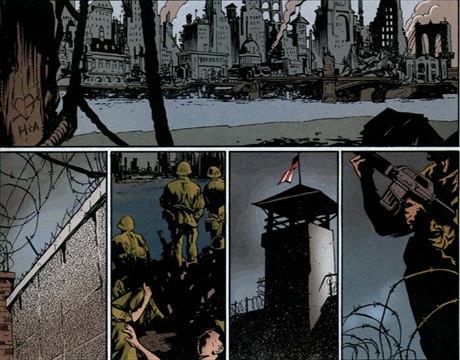
Much like the movie, Bruce Wayne/Batman is absent from the city when this happens. When he returns he spray paints the Bat symbol on the Gotham streets as a means of bringing hope to the people.
This is carried over in the movie, when Blake puts up the chalk Bat symbol for the same reasons.
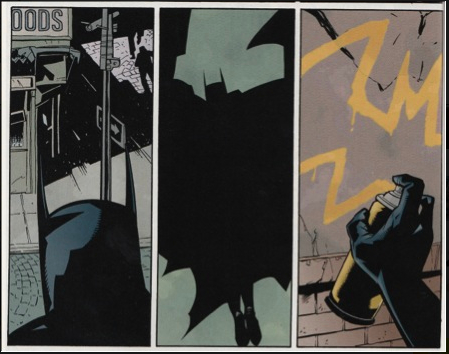
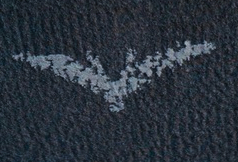
Lastly, Bane's breakout of Blackgate Prison is very similar to his breakout of Arkham Asylum in Doug Moench's 'The Freedom of Madness' (Batman #491, 1993) in the Knightfall story arc. In both stories he uses high-grade weapons to blow open the doors and then equips the liberated prisoners with firearms.
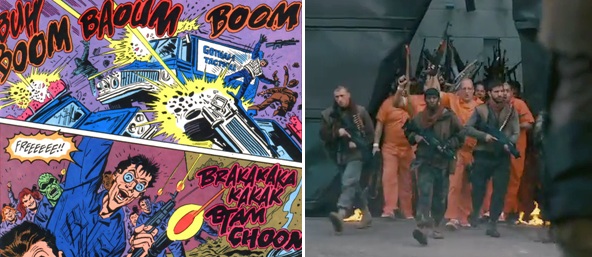
In the film Bruce witnesses the chaos in Gotham from his cell in The Pit. Bane's plan to imprison and torture him is similar, once again, to The Cult, in which Batman gets captured by Deacon Blackfire and is broken, both mentally and physically.
He's imprisoned underground and at one point gets hanged by his arms for days, much like how the older prisoner in the Pit hangs Bruce by his back to help him heal.
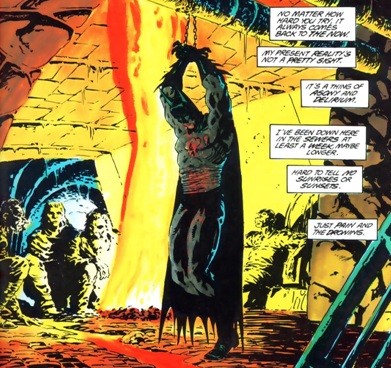
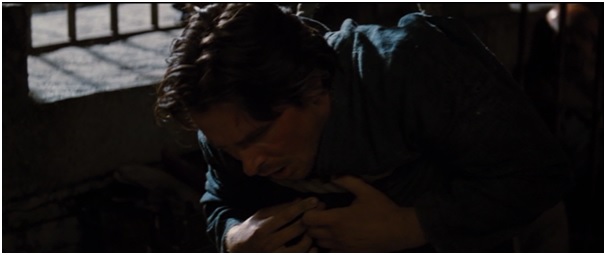
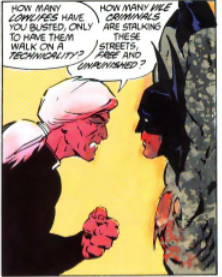
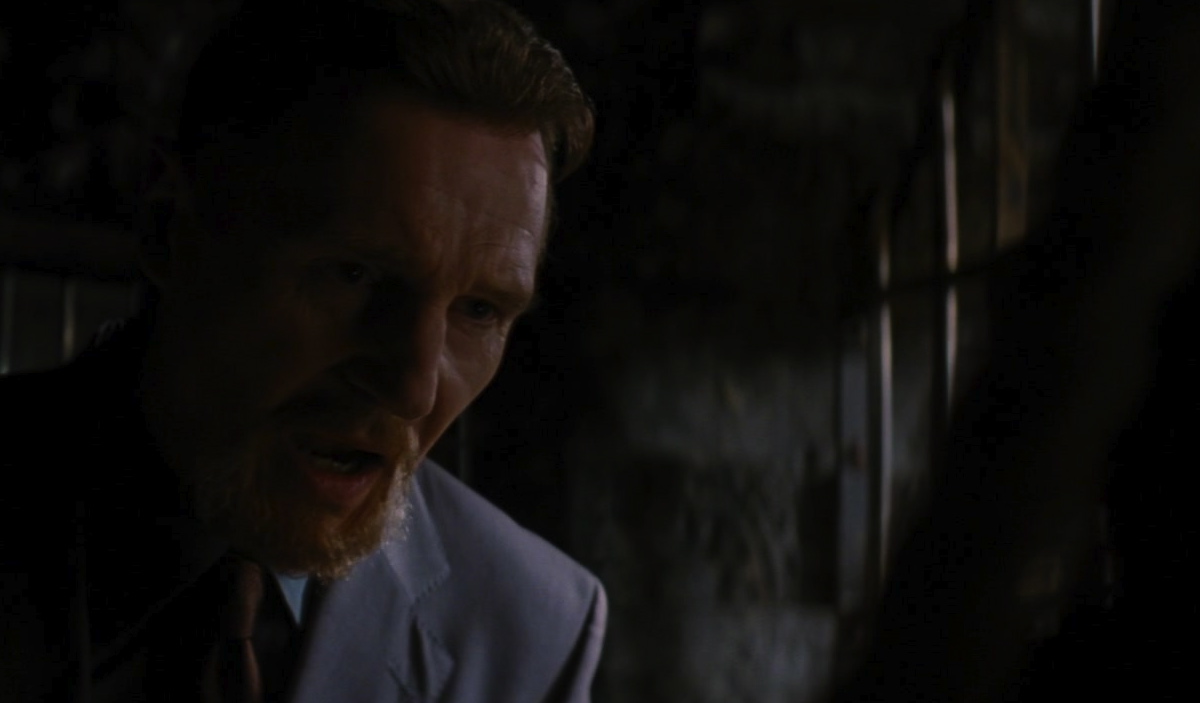
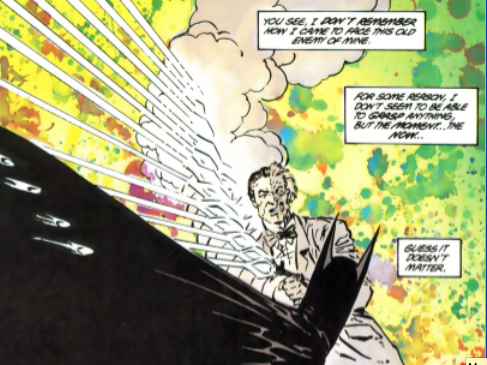

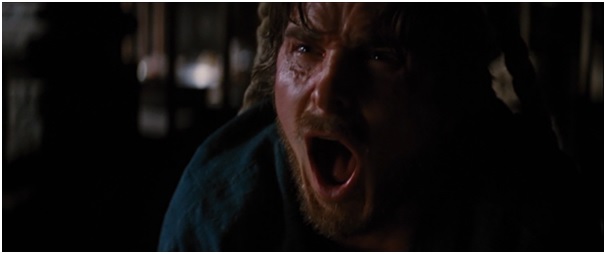
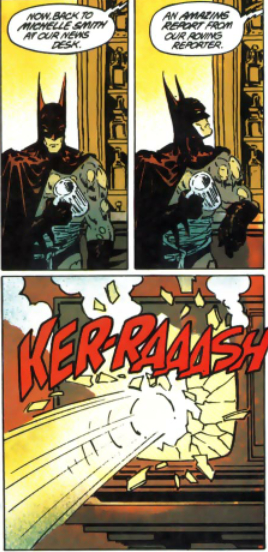

In The Cult the imprisoned Batman is forced to hear legends about Deacon Blackfire's origins, which may or may not be true. The film uses a similar expository device whereby Bruce learns about Bane's supposed origins from the other prisoners in the Pit.

The origin of Bane in the film is somewhat ambiguous. We are initially told that Bane was born in The Pit as a result of his mother's incarceration for a crime his father had committed. This is consistent with Bane's origins in Chuck Dixon's Vengeance of Bane (1993). In the comics, his father was the supervillain King Snake, while the film originally states that it was Ra's Al Ghul. Bane and his mother were incarcerated at Pena Duro in the Caribbean nation of Santa Prisca. His mother died in the prison and he was left to fend for himself.
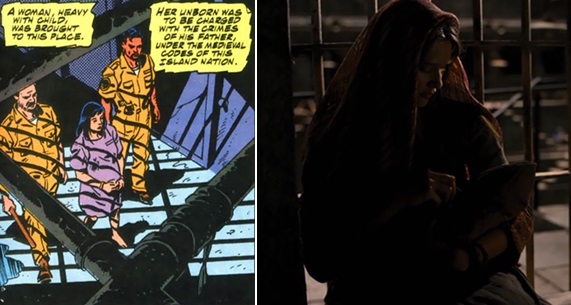
Both the movie and the comic show the imprisoned child falling under the protection of another inmate. In the comics this was Trogg, who later served as one of Bane's henchmen.
The Bane in the comics endured years of solitary confinement under almost unbearable conditions. Ultimately he survived and escaped the prison, earning unrivalled status amongst his fellow prisoners. The child in the movie performs a similar feat, becoming a legend amongst the inmates by climbing out of The Pit.
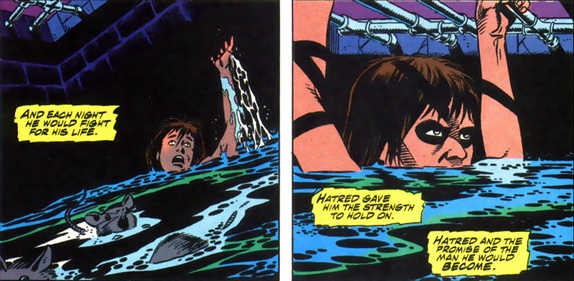

Later in the movie it transpires that the legend of the child is not actually Bane's origin story, but Talia's.
This is another example of Nolan amalgamating two characters from the comics. He did something similar with Henri Ducard and Ra's al Ghul in Batman Begins (2005), and he does it here with Bane and Talia. So we don't really know what the movie Bane's true origin is, though he does mention being "born in darkness."
In the comics, Talia's mother, Melisande, met a tragic fate similar to that of her movie counterpart when a man named Qayin killed her by pushing her into the Lazarus Pit, as depicted in Batman: Son of the Demon (1987). Her death caused Ra's to go after Qayin in search of revenge, much like how Ra's slaughtered the prisoners in The Pit in the movie.
This was later retconned in Dennis O'Neil's Batman: Birth of the Demon (1992), where Talia mentions that her mother died of a drug overdose. In this same comic, the death of Ra's Al Ghul's wife from centuries ago was revealed to have motivated Ra's to turn genocidal in the first place, much like how the film's version of the character used the League of Shadows to slaughter prisoners in the Pit for killing his wife.
As evident in the similarities from comic to screen in Melisande's death, the Pit in the movie is a variation on the Lazarus Pits featured in the comics; places where wounded souls are discarded, only to re-emerge stronger than they were before.
In the case of The Dark Knight Rises, the rebirth is primarily spiritual rather than physical. In both the movie and the comic Batman: Birth of the Demon, an injured Bruce Wayne winds up in The Pit, undergoes a form of rejuvenation and emerges in the desert with a fresh lease of life. The Pit in the movie, however, lacks the supernatural properties of the version in the comics.

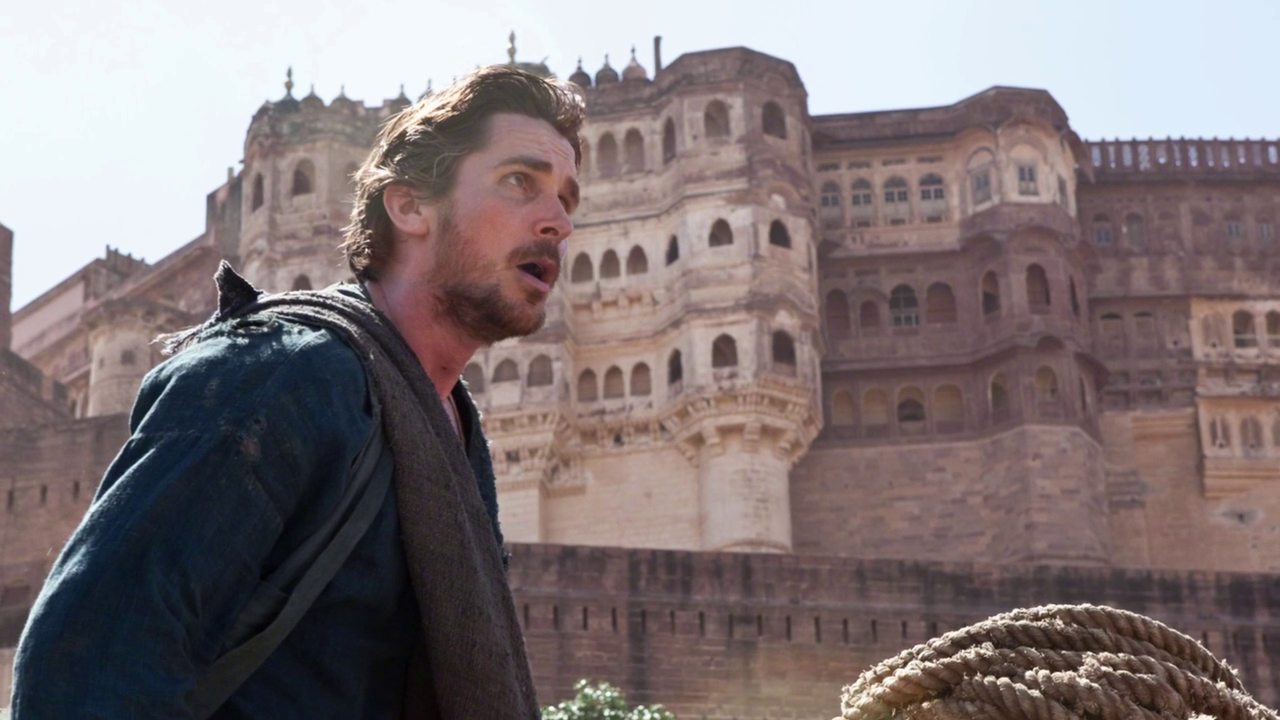
Bruce's actions in the film also reflect those in The Cult, where he escapes from his subterranean prison and goes into exile for a prolonged period of time, leaving the city under the governorship of his enemies while he physically and mentally recuperates from his ordeal.
He then trains himself in preparation to return, and we are told: "The Dark Knight will yet rise from the ashes of defeat."
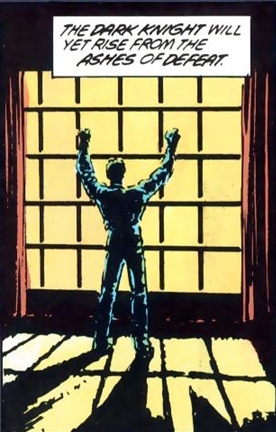
Upon returning to Gotham, Bruce witnesses Selina protecting a kid from a couple of goons who attempt to steal the boy's apple. Selina takes a bite out of the apple before handing it to the kid, echoing a scene from Bob Gale's Batman: No Man's Land Vol 1. #1 (1999), in which the Penguin does the same after auctioning an apple to the highest bidder.
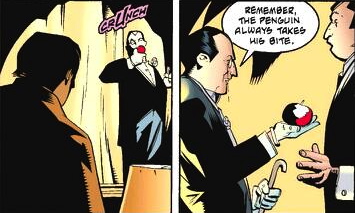
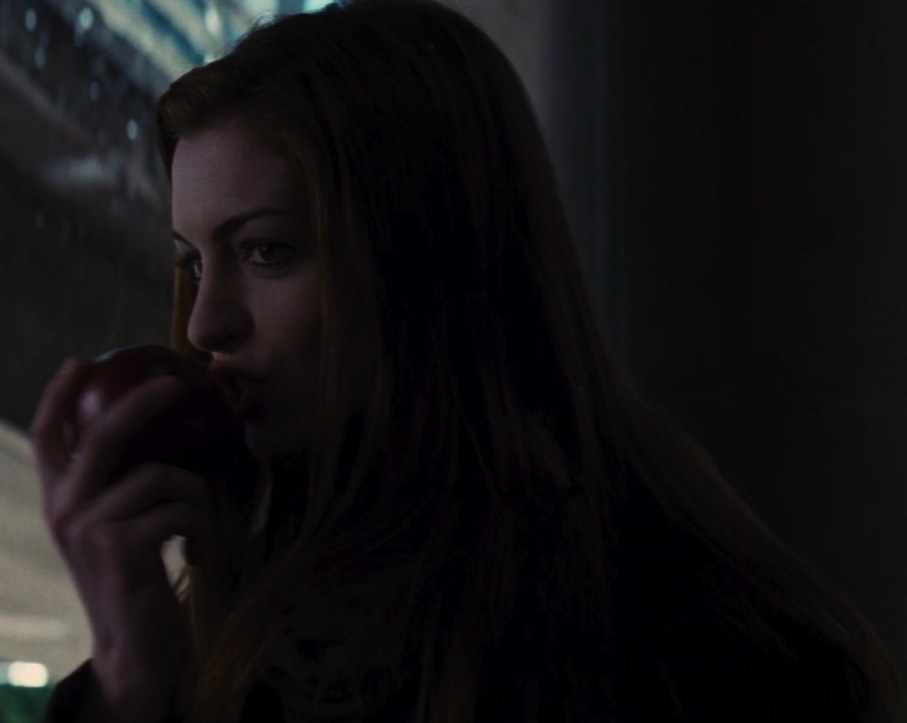
During their subsequent conversation, Bruce offers to give Selina the 'Clean Slate' program in exchange for her help in taking back the city. Despite her betraying him, he still believes that she's a good person deep down. The relationship between Batman and Catwoman in the comics has followed a similar trajectory over the years, with Batman gradually coming to trust Selina as an ally after years of battling her as an enemy. The following example is from Ed Brubaker's Catwoman: The Dark End of the Street (2002).
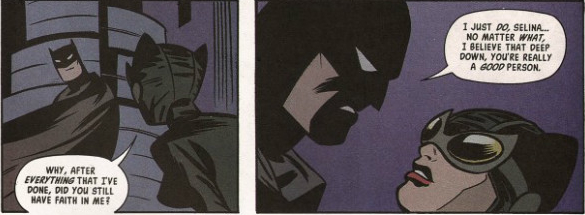
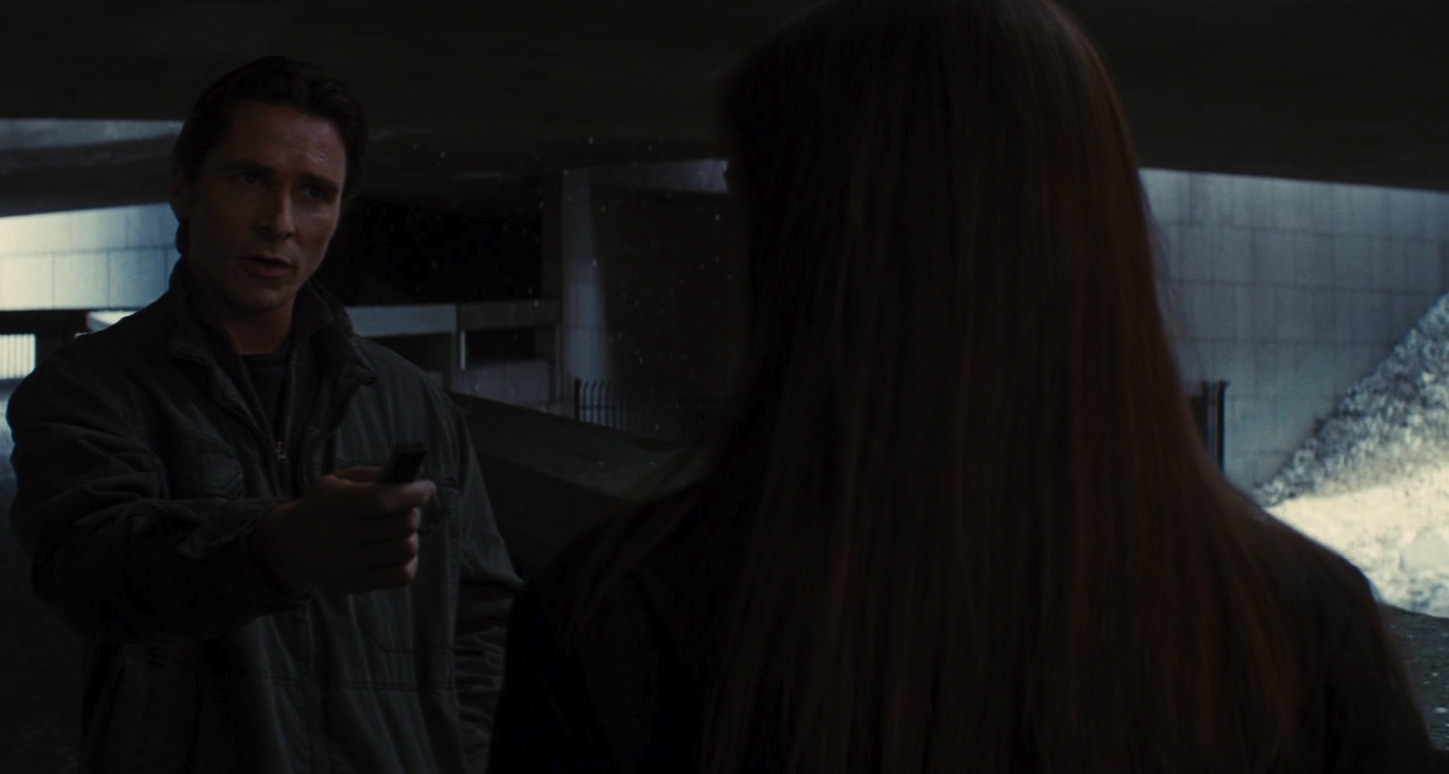
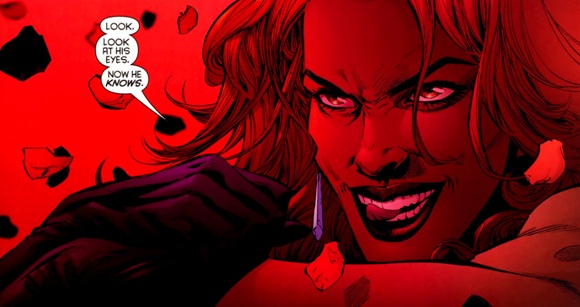
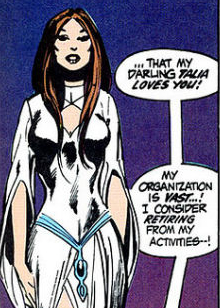
The twist also parallels one of Talia's early appearances in the comics. In the movie Bane takes 'Miranda' hostage. Batman leads the GCPD into fighting Bane and rescuing her, only to discover that 'Miranda' is in no danger at all and has been part of Bane's plot the whole time.
This is similar to Dennis O'Neil's 'Daughter of the Demon' (Batman #232, June 1971), in which Ra's al Ghul approaches Batman to help him rescue Robin and Talia. Batman overcomes Ubu and the rest of the League, only to discover the whole exercise was a ruse concocted by the Demon's Head to test his worthiness as an heir. The story ends with the reveal that Talia is very much safe and was in on the plan from the beginning.
Much like her movie counterpart, Talia al Ghul is hardly a stranger to leading the League of Assassins in her father's absence. After Ra's died in Greg Rucka's Death and the Maidens (2003-2004) and her sister Nyssa was killed during the One Year Later arc, Talia assumed leadership of the League, beginning with Grant Morrison's Batman and Son in 2006 and continuing into today's stories with Batman Incorporated.
It's made clear during the film's finale that both Talia and Bane are willing to sacrifice themselves by staying in Gotham when they detonate the nuke. This again draws parallels with Deacon Blackfire in The Cult, who was also willing to die for his cause after taking over the city.
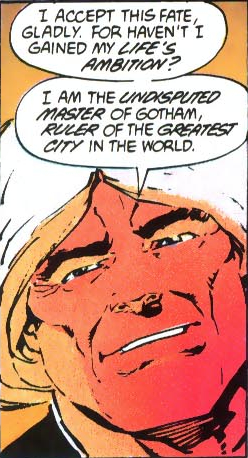
Blackfire's power and fanaticism forced Batman to take extreme measures in battling him. Much like the movie, Batman and Robin stormed the city with Bruce's latest assault vehicle, clearing the way for the army to take back Gotham.
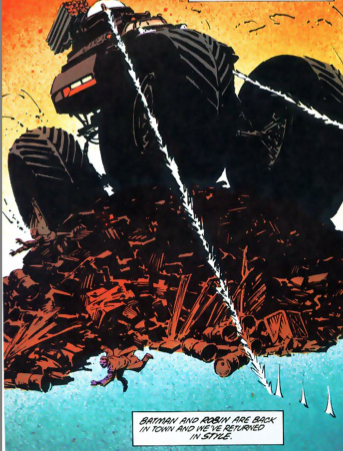
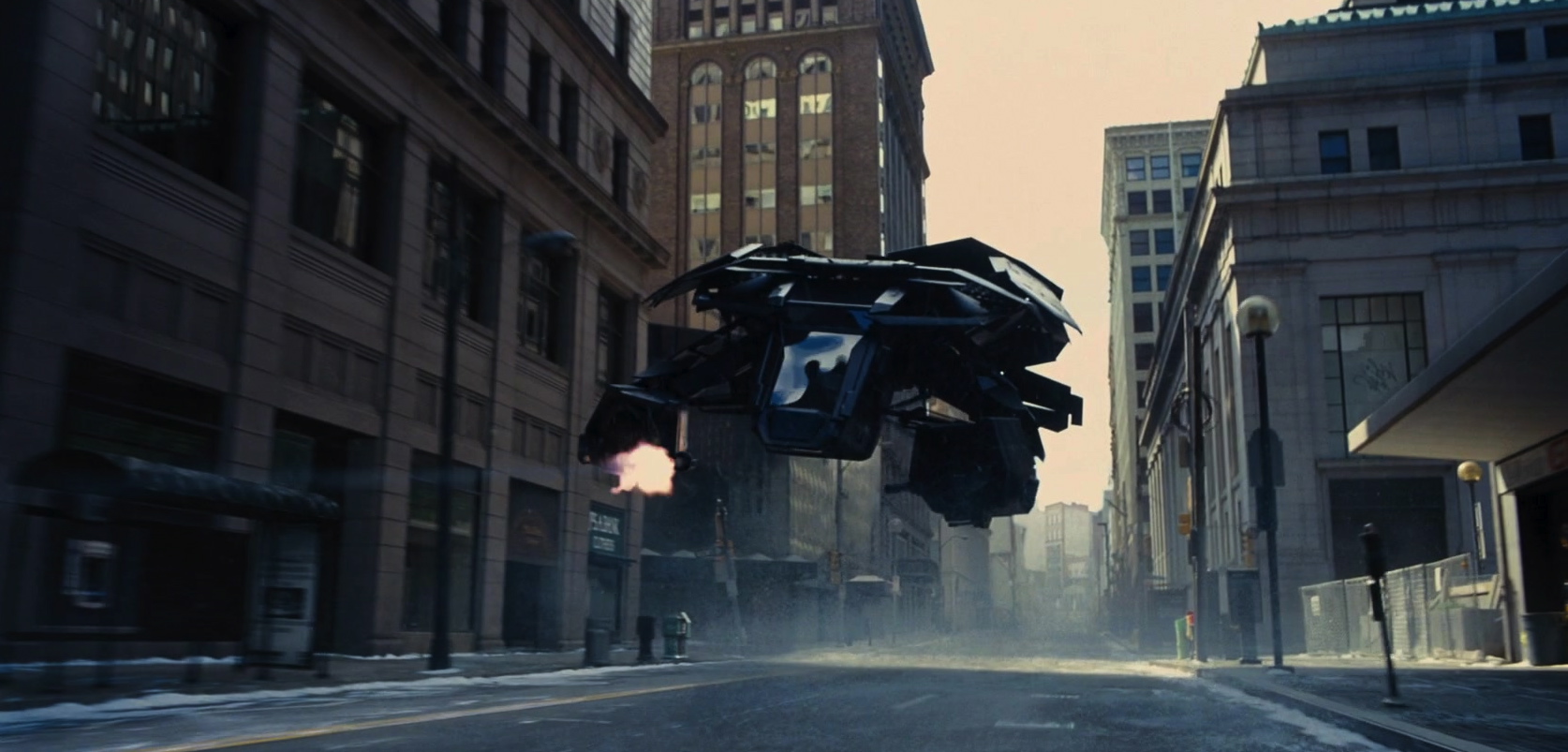
In the comic, the Dynamic Duo resorted to using guns and explosives to battle Blackfire's hordes.
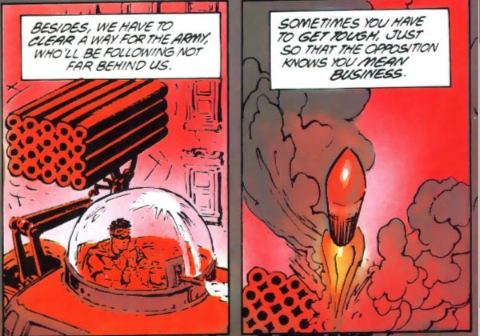

This is similar to how Batman uses the machine guns on The Bat in the finale of the movie, opening fire on Talia's van and causing the deaths of both her and her driver.
This may seem like an uncharacteristically bloodthirsty act on Batman's part, but it has a famous precedent in the classic Golden Age comic 'The Giants of Hugo Strange' by Bill Finger (Batman #1, Spring 1940); a story that also influenced the Batwing showdown in Tim Burton's Batman (1989), as written by Sam Hamm and Warren Skaaren.
The 1940 comic climaxes with a scene in which Batman uses the guns on the Batplane to kill a group of Hugo Strange's henchmen, who are also driving in a van.
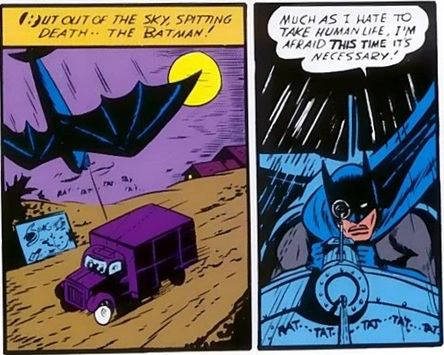
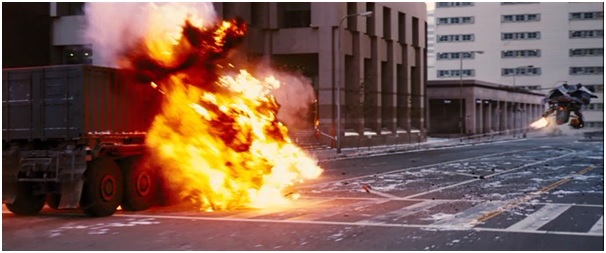
A stronger tie between the movie and The Dark Knight Returns is the ending. Both the movie and the comic end with Batman faking his own death, allowing the world to believe that both Bruce Wayne and Batman have perished.
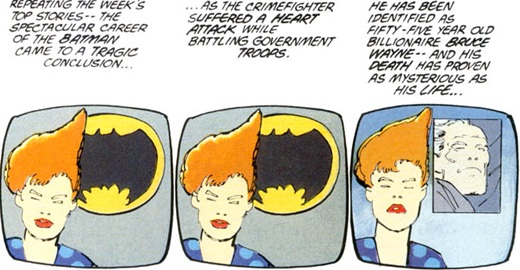
The supposed death of Bruce/Batman has been covered in other comics as well. In Batman R.I.P., Dick Grayson witnesses a helicopter explode with Batman allegedly onboard. This is similar to how John Blake witnesses the Bat explode in the movie. Although Bruce/Batman later resurfaces, this is the last time that Dick sees his mentor before he is ostensibly "killed" by Darkseid.

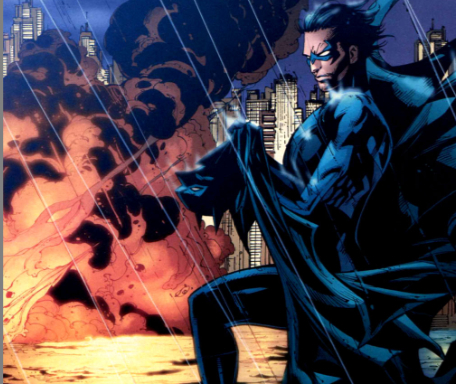
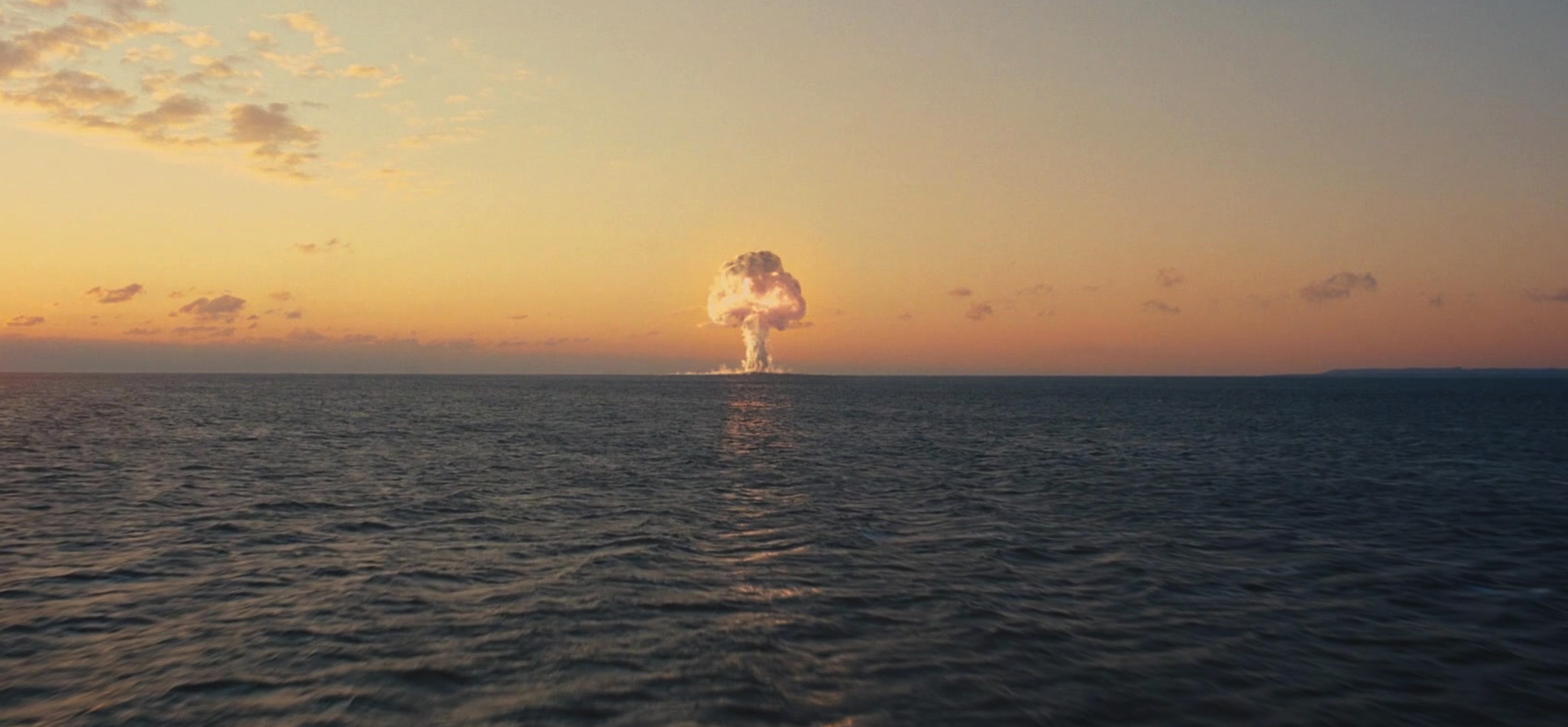
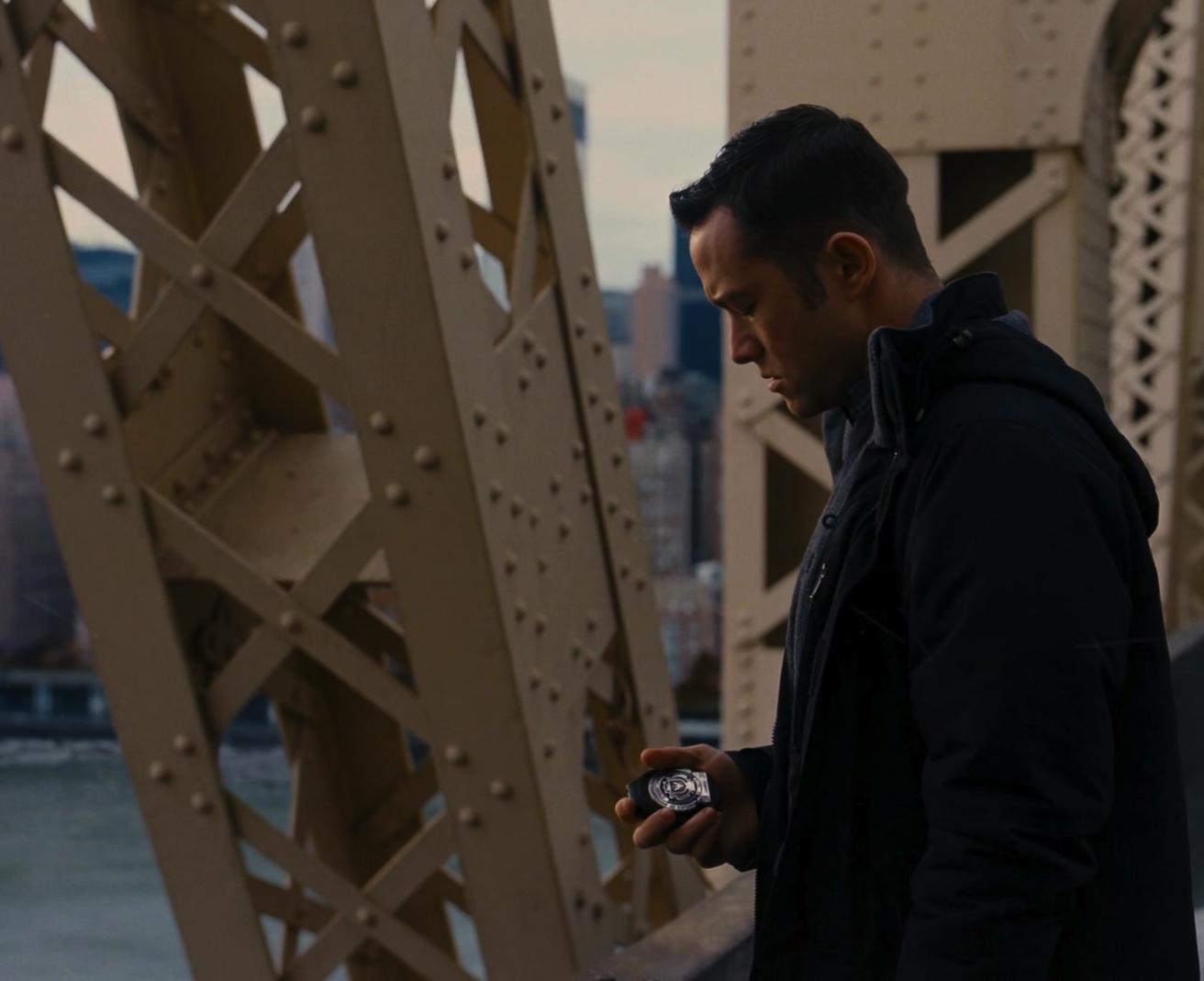
Bruce Wayne also fakes his death at the end of Doug Moench's Elseworlds comic, Batman & Dracula: Red Rain (1991). Afterwards a solicitor informs Alfred that Bruce named him executor of his estate, stipulating that his wealth be used to help the homeless.

Alfred bids a mournful farewell at his master's graveside.
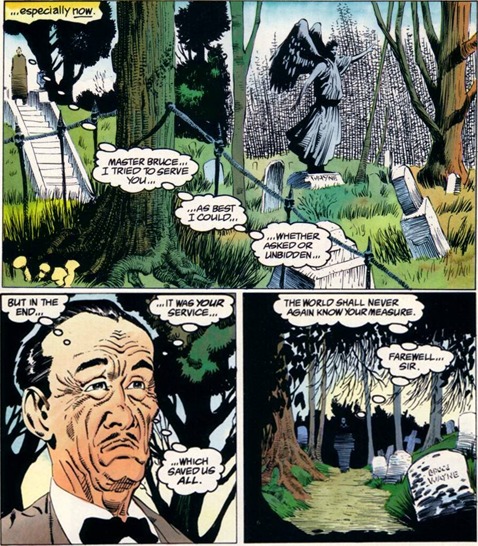
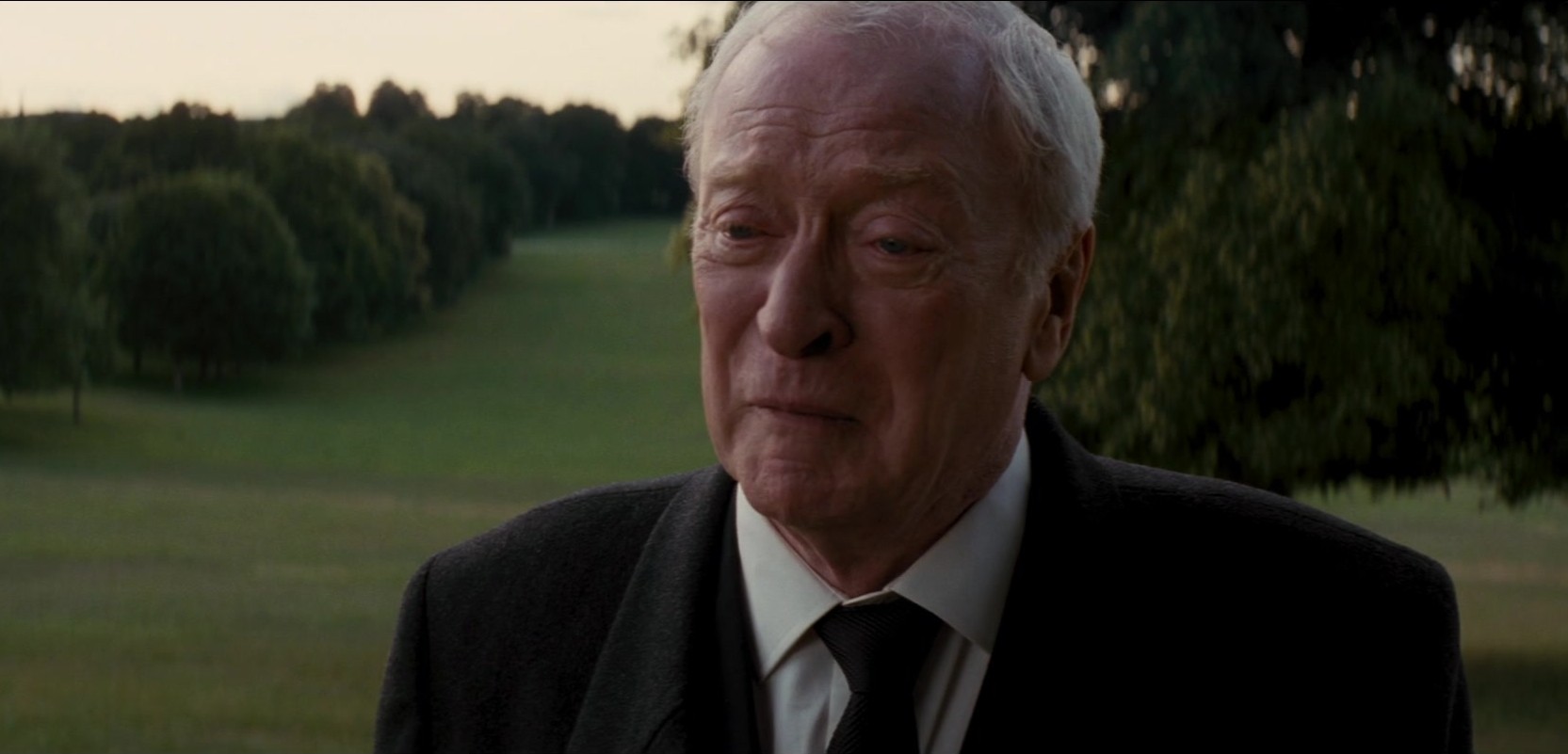
Batman/Bruce was also thought to have been killed by Darkseid in Grant Morrison's Final Crisis (2008-2009). Peter Tomasi's Batman and the Outsiders Special #1 (2009) showed Alfred in another mourning scene. This included dialogue similar to that in the film, where Alfred expresses regret over failing the Wayne family.

It's worth noting that in the film the solicitor gives Alfred the full name 'Alfred J. Pennyworth.' The character's full name in the comics, however, is Alfred Thaddeus Crane Pennyworth. It's possible that the 'J' initial is a nod to Alfred's father in the comics, Jarvis Pennyworth, making the character's full name Alfred Jarvis Pennyworth in The Dark Knight trilogy.
On the subject of full names, John Blake's full name is revealed to be Robin John Blake, making Robin his actual birth name, as opposed to the costumed alias that Dick Grayson and others have adopted in the comics. A similar reimagining of the character was done in Paul Pope's Batman Year 100, in which a young man named Robin helped a futuristic Batman. Like Robin John Blake, the Year 100 Robin never donned the red, green, and yellow suit in the story, though he did wear the Batsuit to help the real Batman create a diversion.
At the end of the film, Alfred uses what's left of Bruce's money for traveling. This is similar to the end of the Knightfall arc, in which Alfred was revealed to have gone traveling around the world after leaving Bruce's employ (Nightwing: Alfred's Return, Alan Grant, 1995).
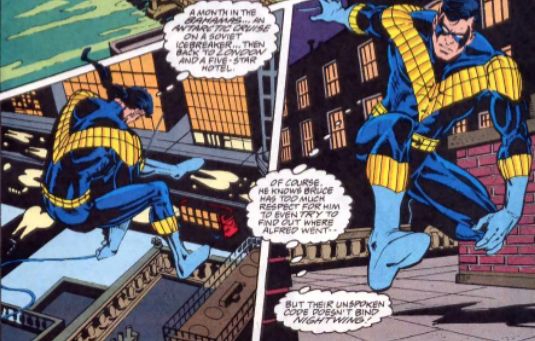
It's in Florence, Italy that Alfred discovers Bruce and Selina have started a new life together. This echoes their marriage in the Earth-Two canon, as depicted in E. Nelson Bridwell's 'The Kill Kent Contract!' (Superman Family #211, October 1981).
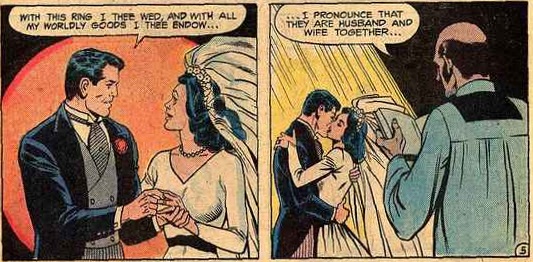

The movie also implies that Blake will assume the mantle of Batman following Bruce Wayne's retirement. This is actually not the first time a police officer has replaced Bruce as Batman. In Don Cameron's 1944 Batman newspaper comic strip, 'The Secret of Triangle Farm', Batman was injured and had to trust GCPD Sgt. Bill Randall to take over for him beneath the cowl.
Years later, in 1947's Batman #40, 'The Case of Batman II' by Bill Finger, Bruce Wayne would fake his death and assume the identity of 'Bill Randall' to become Batman II. As in the film, Alfred was unaware that Bruce was still alive.
Of course Dick Grayson has always been the logical choice to replace Bruce in the comics. We've seen this in recent years following Tony Daniel's Battle for the Cowl storyline. It also happened in the Earth-Two timeline, when Dick briefly became Batman to capture the Joker following Bruce Wayne's death at the hands of Bill Jensen in Paul Levitz's 'Only Legends Live Forever' (Adventure Comics #461-462, 1979).
In addition to this, the idea of Bruce Wayne selecting a younger man to replace him as Batman is the premise of the Batman Beyond animated series (1999-2001). In that sense, John Blake can be seen as a variation of the Terry McGinnis character as well.
Bruce's decision to retire for good at the end of the movie has been controversial among fans, as the Bruce Wayne in the comics has stated on more than one occasion that he will never quit being Batman, as noted here in Neil Gaiman's Whatever Happened to the Caped Crusader? (2009).
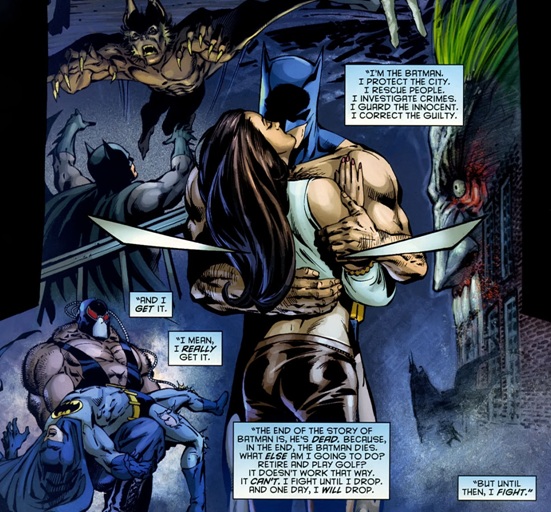
The idea of Bruce willingly abandoning his crusade against crime to pursue a more ordinary existence is a significant departure from what we've seen in the comics.
Though that's not to say it isn't a fitting ending to Nolan's Batman saga.
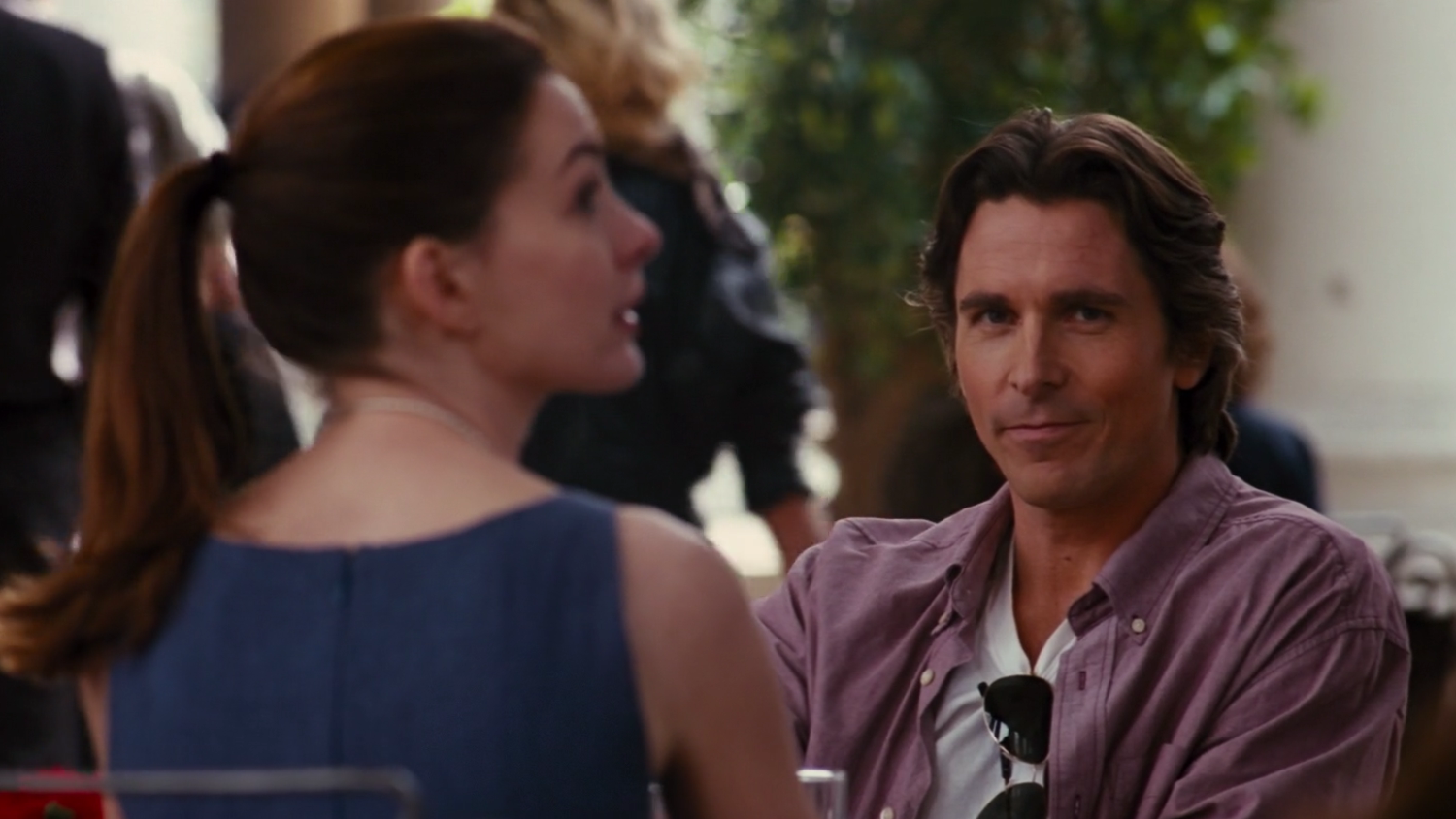
This concludes Batman Online's analysis on the comic book influences on The Dark Knight Rises.
We want to hear your thoughts, readers! Which parts did you prefer in the comics? Which parts did you prefer in The Dark Knight Rises? Comment in the section below!













by The Dark Knight
by Silver Nemesis
by The Dark Knight
by The Joker
by Slash Man
by Silver Nemesis
by The Dark Knight
by Slash Man
by Slash Man
by The Joker